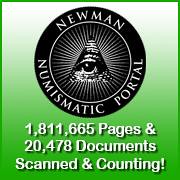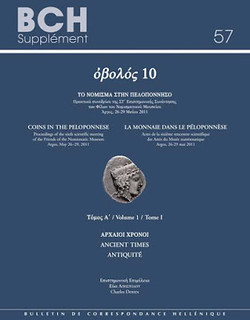
About UsThe Numismatic Bibliomania Society is a non-profit organization devoted to the study and enjoyment of numismatic literature. For more information please see our web site at coinbooks.org SubscriptionsThose wishing to become new E-Sylum subscribers (or wishing to Unsubscribe) can go to the following web page link MembershipThere is a membership application available on the web site Membership Application To join, print the application and return it with your check to the address printed on the application. Print/Digital membership is $40 to addresses in the U.S., and $60 elsewhere. A digital-only membership is available for $25. For those without web access, write to: Terry White, Treasurer AsylumFor Asylum mailing address changes and other membership questions, contact Terry at this email address: terrywhite5475@yahoo.com SubmissionsTo submit items for publication in The E-Sylum, write to the Editor at this address: whomren@gmail.com BUY THE BOOK BEFORE THE COINSale Calendar
|
- WAYNE'S WORDS: THE E-SYLUM JUNE 24, 2018
- KOLBE & FANNING OFFER ADAMS LYMAN LOW CATALOGUES
- NEW BOOK: THE COPPER COINS OF VERMONT
- NEW BOOK: PACIFIC COAST EXPO SO-CALLED DOLLARS
- NEW BOOK: OBSOLETE PAPER MONEY GUIDE WITH PRICES
- NEW BOOK: FUR MONEY OF MEDIEVAL RUSSIA
- NEW BOOK: FRENCH SOUTHEAST ASIA COINS & CURRENCY
- NEW BOOK: LES ENVELOPPES ROUGES (RED ENVELOPES)
- NEW BOOK: SVERIGES RIKSBANK
- NEW BOOK: COINS IN THE PELOPONNESE
- BOOK REVIEWS: ANCIENT COINS IMAGES, POMPEII
- 2018 NATIONAL HISTORY DAY WINNER
- SCIENTIFIC AMERICAN ON NEWMAN NUMISMATIC PORTAL
- STONE MOUNTAIN COMMEMORATIVE HALF RESEARCH
- BILL ECKBERG ON COIN INVESTMENT
- AUDIO: HALL AND DANNREUTHER CREATE PCGS
- NOTES FROM E-SYLUM READERS: JUNE 24, 2018
- MORE ON THE HAWAII STATEHOOD MEDAL
- SS CENTRAL AMERICA WORLD GOLD COINS
- THE S.S. CENTRAL AMERICA'S LOST MINT DOCUMENTS
- NIST INVESTIGATES NICKEL COMPOSITIONS
- VOCABULARY TERM: TOPIC
- WALDO CLIFTON MOORE (1874-1953)
- THE RISE AND FALL OF BRUCE MCNALL
- A COIN WITH A GREAT PEDIGREE
- ELIASBERG 1913 LIBERTY NICKEL OFFERED
- WALTON 1913 LIBERTY NICKEL SOLD
- EXHIBIT: WHAT IS MONEY?
- QUEER COINS: LGBTQ RULERS THROUGH HISTORY
- SELECTIONS FROM DAVE WNUCK'S 'MAKING THE GRADE' #39
- WAYNE'S NUMISMATIC DIARY: JUNE 24, 2018
- SOLOMON ISLANDS FEATHER MONEY
- MEDAL HONORS AFRICAN AMERICAN WWI HERO
- SOUTH AFRICA ISSUES MANDELA COINS AND BANKNOTES
- CLYDESDALE, YORKSHIRE BANKS NOW VIRGIN MONEY
- RUSSIA'S SOUVENIR WORLD CUP BANKNOTE
- AFRICAN FINANCIAL COMMUNITY CURRENCY CHALLENGED
- INDIAN RATS DEVOUR ATM CASH
- HONG KONG CLARIFIES MOVIE MONEY RULES
- LIBERTY DOLLAR RESURRECTED AS CRYPTOCURRENCY
- IN OTHER NEWS: JUNE 24, 2018
Click here to access the complete archive a
Click here to unsubscribe (scroll down)
To comment or submit articles, reply to whomren@gmail.com
Content presented in The E-Sylum is not necessarily researched or independently fact-checked, and views expressed do not necessarily represent those of the Numismatic Bibliomania Society.
WAYNE'S WORDS: THE E-SYLUM JUNE 24, 2018
 New subscribers this week include: Giacomo Pardini and Cristaldo Olazar, courtesy of Peter Preston-Morley; and Sue Curry. Welcome aboard!
We now have 5,763 subscribers.
New subscribers this week include: Giacomo Pardini and Cristaldo Olazar, courtesy of Peter Preston-Morley; and Sue Curry. Welcome aboard!
We now have 5,763 subscribers.
Thank you for reading The E-Sylum. If you enjoy it, please send me the email addresses of friends you think may enjoy it as well and I'll send them a subscription (but let me know if they are located in the European Union). Contact me at whomren@gmail.com anytime regarding your subscription, or questions, comments or suggestions about our content.
This week we open with more great lots from the upcoming Kolbe & Fanning sale, TEN books, a National History Day numismatic winner, and a great addition to the Newman Numismatic Portal.
Other topics this week include the copper coinage of Vermont, Stone Mountain commemorative halves, the early days of PCGS, world coins and branch mint documents carried on the SS Central America, 1913 Liberty Nickels, 1933 Double Eagles, Gutzon Borglum, Agoston Haraszthy, Waldo Moore, Bruce McNall and Extra von NotHaus.
To learn more about the Rupert E. Kingsford sale, French Southeast Asian Coins and Currency, Cultural Revolution style red packets, a cheaper way to produce nickels, queer coins, the Beauregard Dime, Solomon Islands feather money and the fur money of medieval Russia, read on. Have a great week, everyone!
Wayne Homren
Editor, The E-Sylum
KOLBE & FANNING OFFER ADAMS LYMAN LOW CATALOGUES
KOLBE & FANNING IN THE JOHN W. ADAMS LIBRARY SALE
July 14, 2018 Sale Includes the Withdrawn Kingsford Catalogue and Other Rarities
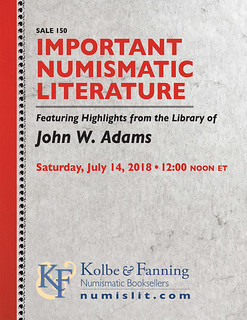 On July 14, 2018, Kolbe & Fanning Numismatic Booksellers will be celebrating our 150th Auction by offering highlights of the John W.
Adams numismatic library.
On July 14, 2018, Kolbe & Fanning Numismatic Booksellers will be celebrating our 150th Auction by offering highlights of the John W.
Adams numismatic library.
The Adams Library includes one of the finest collections of American numismatic auction catalogues ever assembled. Among the highlights is a complete set of catalogues issued by New York coin dealer Lyman H. Low, including all of his plated sales, the complex series of early sales, and the extremely rare 1885 catalogue of the R.E. Kingsford sale, withdrawn by the consignor while the catalogue was being printed.
Active from 1883 until his death at the age of 79 in 1924, Lyman Low combined a rare ability to succeed commercially while sustaining a series of scholarly publications and an active career as a numismatic editor. He served as editor of the American Journal of Numismatics for nearly two decades, and published what remains the standard work on Hard Times Tokens, along with other works. His areas of particular interest included Spanish-American coinage, U.S. and Canadian token issues, medals, and foreign copper coins. As a cataloguer, he issued no fewer than 212 sale catalogues.
The Adams Library's holdings of Lyman Low catalogues are being offered as follows:
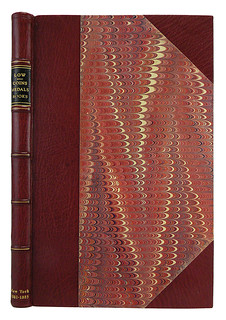
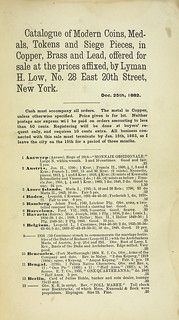
Lot 252
Lot 252: Lyman Low's own set of his early fixed price lists, with various miscellaneous publications from the period before his sojourn with Scott & Company, many of which are very rare.
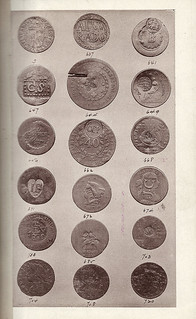

Lots 253 and 254
Lot 253: the early Low auction catalogues, including complete copies of the very rare plated catalogues of his fifth and eighth sales from the library of William G. Jerrems, the first ANA President.
Lot 254: the extremely rare 1885 catalogue of the Rupert E. Kingsford sale, withdrawn by the consignor as the catalogue was being printed and extant today in perhaps only three copies salvaged from the page proofs.
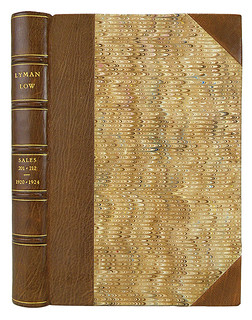
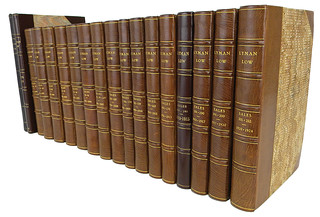
Lot 255
Lot 255: an extraordinary complete set, mostly present in eighteen fine bindings, of the later Lyman Low catalogues, constituting 185 sale catalogues issued from 1896 through 1924.
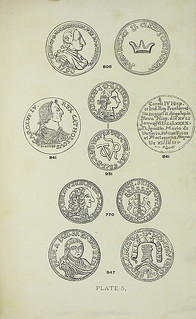
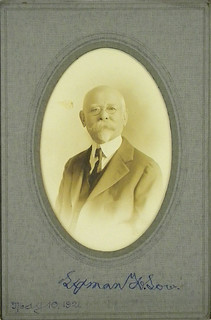
Lots 256 and 257
Lot 256: a bound volume including copies of two of Low's most important sales, that of Benjamin Betts (1898) and the Hays-Phelps 1794 large cents (1907).
Lot 257: a fine studio photograph of Low, taken in 1921 and signed by him on the original decorative cardboard frame.
The extensive, full-color catalogue of the Adams Library is now available at bid.numislit.com. The sale will feature live online bidding using Kolbe & Fanning’s custom third-party online bidding platform. Printed catalogues have recently been mailed to established customers, who should receive their copies shortly. Bidders wishing to make an appointment to view auction lots are invited to contact David Fanning at df@numislit.com.
Kolbe & Fanning Numismatic Booksellers LLC is a licensed and bonded auction firm in the State of Ohio. For more information, please see the Kolbe & Fanning website at numislit.com or email David Fanning at df@numislit.com.
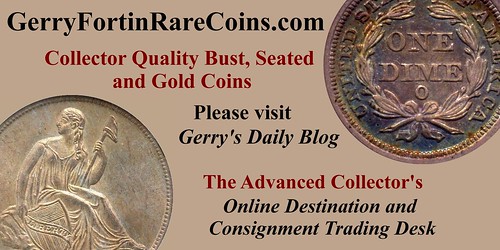
NEW BOOK: THE COPPER COINS OF VERMONT
By Q. David Bowers
A Rarity is Created!
Perhaps one you’d like to own, especially if you like numismatic history!
 It was as a teenager in the 1950s that Dave Bowers began studying and collecting the 1785-1788 copper coins issued by the Republic of
Vermont (which did not become a state until 1791). From then down to today he has bought, sold, and collected many pieces, including those our firm
has handled in “name” collections.
It was as a teenager in the 1950s that Dave Bowers began studying and collecting the 1785-1788 copper coins issued by the Republic of
Vermont (which did not become a state until 1791). From then down to today he has bought, sold, and collected many pieces, including those our firm
has handled in “name” collections.
Dave has kept a file of interesting anecdotes, stories, historical accounts, and more. He has combined these with a definitive text on all 39 different Vermont die combinations with technical aspects, rarity, and more. The Copper Coins of Vermont and Interrelated Issues 1783-1788 is guaranteed not only to be filled with important information, but to be a “good read” as well. The foreword is by Ray Williams, well known in the field of early American coins.
As to the rarity of the book, this is a limited-edition, with a run of just 500 copies. The book is 176 pages, large 8½ by 11 inches in size, quality hardbound, and in full color. Each will have a special numbered bookplate (1 to 500) signed by Dave. Shipment is expected in August.
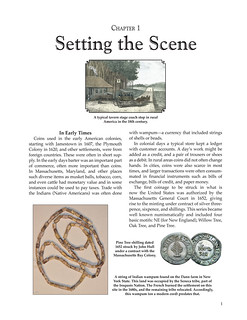
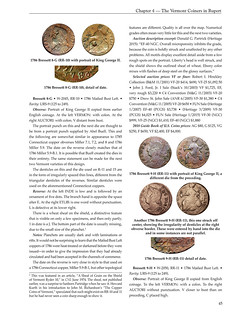
List price: $39.95 (if any remain after this offer)
Prepublication special: Just $29.95 plus $5 shipping to U.S. addresses. Limit: 2 copies per household. This offer is subject to prior sale and confirmation by us. (Pre-publication special expires Friday, July 20, 2018)
To order: Call 866-811-1804 or 603-569-0823 and pay with a credit card. Or you can send a check (made out to Stack’s Bowers Galleries) to Stack’s Bowers Galleries/PO Box 1804/Wolfeboro, NH 03894/Attn: Book Sales.
NEW BOOK: PACIFIC COAST EXPO SO-CALLED DOLLARS
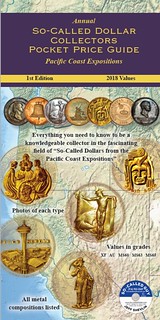 The annual “So-Called Dollar Collectors Pocket Price Guide” provides values for so-called dollars and is published in conjunction with the
book “So-Called Dollars from the Pacific Coast Expositions”. Eight expositions were held on the Pacific Coast:
The annual “So-Called Dollar Collectors Pocket Price Guide” provides values for so-called dollars and is published in conjunction with the
book “So-Called Dollars from the Pacific Coast Expositions”. Eight expositions were held on the Pacific Coast:
• 1894 California Midwinter International Exposition
• 1905 Lewis & Clark Centennial Exposition
• 1909 Alaska-Yukon-Pacific Exposition
• 1915 Panama-Pacific International Exposition
• 1915-16 Panama-California Exposition
• 1935-36 California Pacific International Exposition
• 1939-40 Golden Gate International Expositions
• 1962 Seattle World’s Fair Exposition
In addition to providing values for so-called dollars from the pacific coast expositions in grades EF-40, AU-50, MS-60, MS-63 and MS-65, the Pocket Price Guide has high quality photos of each type, rarity information and identifies all the various metal compositions they were struck in. There is a check box for each variety with room for notes so collectors can keep track of what they have and what they are looking for. Each year additional so-called dollars will be added to the Pocket Price Guide until all so- called dollars are included.
So-called dollars are historical U.S. medals that commemorate a person, place or event in the United States history. They are 33mm to 45mm in size. There are dozens and dozens of medals included in the book that were never before cataloged. Using the 1905 Lewis & Clark exposition as an example, the reference book by Hibler and Kappen originally published in 1963 catalogs four different design types and a total of 14 varieties, considering different metal compositions. The new standard reference for the Lewis & Clark Exposition expands from four design types to 16 different design types and from 14 varieties to 30 different varieties.
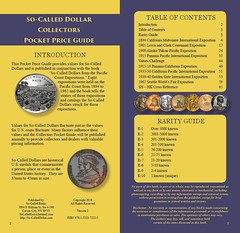
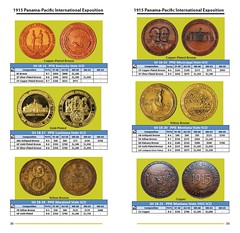
Collectors interested in medals from the eight expositions held on the Pacific Coast will now have photos and information on medals they probably did not know existed. The Pocket Price Guide and soon to be released book “So-Called Dollars from the Pacific Coast Expositions” authored by Jeff Shevlin and Bill Hyder are a collaborative effort involving dozens of collectors that have shared their knowledge and many years of research. The book tells the fascinating numismatic stories of the eight expositions held on the Pacific Coast and catalogs all of the historically significant so-called dollars struck at those expositions.
The so-called dollar market is strong. There are many factors contributing to the surging interest in historical U.S. medals and specifically so-called dollars. The Mega Red Book, which was first published four years ago, has annually included extensive coverage of these historical medals. Mega Red Book IV, which came out in April of this year, has 16 pages devoted to the so-called dollars from the 1915 Panama- Pacific International Exposition. Shevlin has made two appearances on the television show Pawn Stars selling and promoting so-called dollars, he has given dozens of presentations, written dozens of articles as well as written books promoting the numismatic hobby and specifically U.S. historical medals, so-called dollars.
Values for so-called dollars fluctuate just as values for U.S. coins fluctuate. Many factors influence their values and the Collectors Pocket Price Guide will be published annually to provide collectors and dealers with valuable pricing information.
The Pocket price Guide is $19.95, shipping is $4.50
To order your book contact:
Jeff Shevlin, the So-Called Guy
1894 E. Willian St., Suite 4-240
Carson City, NV 89701
Phone: (916) 955-2569
Email: SoCalledGuy@Hotmail.com
http://So-CalledDollar.com
To read the earlier E-Sylum article, see:
BOOK REVIEW: PACIFIC COAST EXPO SO-CALLED DOLLARS
(http://www.coinbooks.org/v21/esylum_v21n24a04.html)
Jeff adds:
Dick Johnson is not only a great writer, he is also very observant. In his book review of "The So-Called Dollar Collectors Pocket Price Guide" he stated "each exposition's medal photos has a separate background color, a useful and innovative feature".
Each exposition had a master color scheme for the buildings and other attractions. When developing our book, Bill Hyder and I selected a color for each section that replicated the actual color scheme used for that exposition.
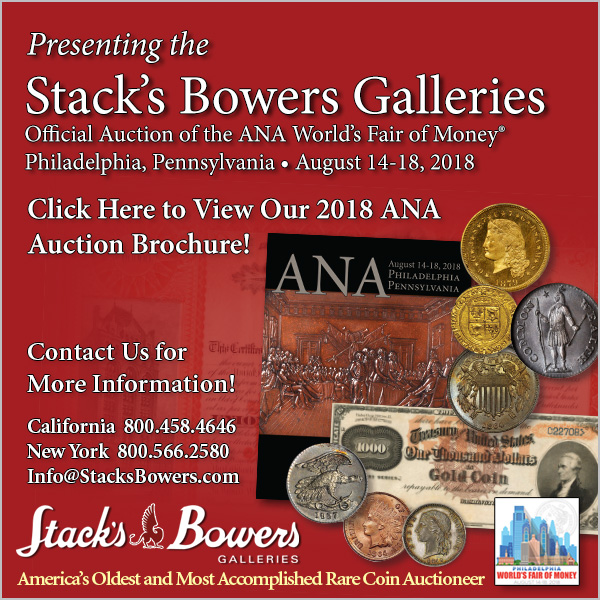
NEW BOOK: OBSOLETE PAPER MONEY GUIDE WITH PRICES
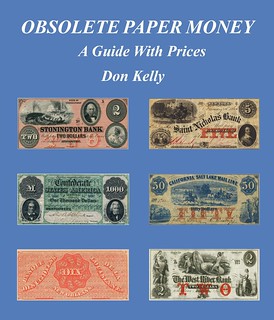 OBSOLETE PAPER MONEY, A Guide With Prices
OBSOLETE PAPER MONEY, A Guide With Prices
Sample pages from our new book - 624 pages - chock full of pictures and prices. Actual page size is standard 8 1/2 by 11.
This book covers obsolete notes from all states and regular Confederate States issues.
Available in Perfect Bound (paperback) and Spiral Bound (laminated cover).
Prices are as follows:
Perfect Bound $80
Spiral Bound $90
These prices include shipping.
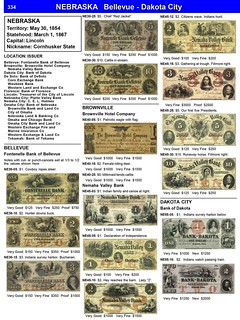
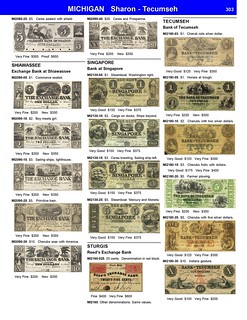
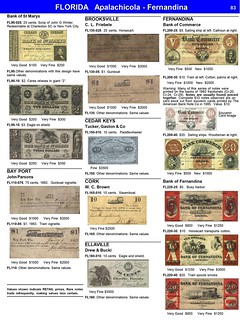
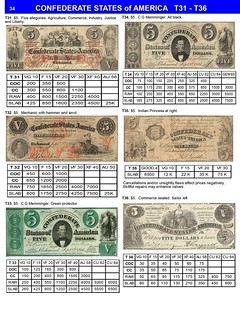
To place your order you can send a check or money order to: Don Kelly PO Box 85 Oxford OH 45056
- or - To use your credit/debit card send address and card information to: obsolete.book@gmail.com or by phone at (513-255-6620).
For more information, or to order, see:
OBSOLETE PAPER MONEY, A Guide With Prices
(http://www.donckelly.com/obsolete/OPM_SAMPLE.html)
To read the complete Coin World article, see:
Newly published price guide for
obsolete notes welcomed at show (https://www.coinworld.com/news/paper-money/2018/06/new-price-guide-for-obsolete-notes-published.html)
NEW BOOK: FUR MONEY OF MEDIEVAL RUSSIA
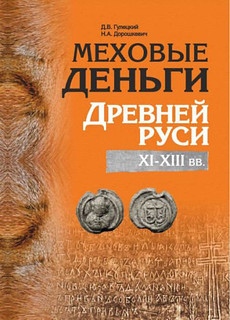 FUR MONEY of Medieval Russia
FUR MONEY of Medieval Russia
Russian language with English summary
280 colour pages.
Hard cover.
Released in 2018.
ISBN: 9789857157884.
The end of the first millennium was marked in Kievan Rus’ by the beginning of abundant coinage. “Srebreniks” and “zlatniks” of Vladimir Svyatoslavich were considered for a long time to be the first Russian currency. Confidence in this fact was recently shaken by new investigations of peculiar Russian Kufic dirham imitations that first appeared in the middle of the 10th century. After the death of Vladimir in Kiev (1015), silver coins continued to be issued by his successor Svyatopolk (who ruled until 1019). This duke was soon defeated and expelled from the throne by his brother Yaroslav, who did not resume the mintage of “srebreniks”.
What replaced these coins? How was small-scale trade carried out in the lands that never used “srebreniks” (for example, Polotsk)? Was it satisfied only with natural exchange? Insufficient knowledge of Russian monetary circulation in the 11th through the beginning of the 13th centuries is primarily due to the scarcity of historical sources.
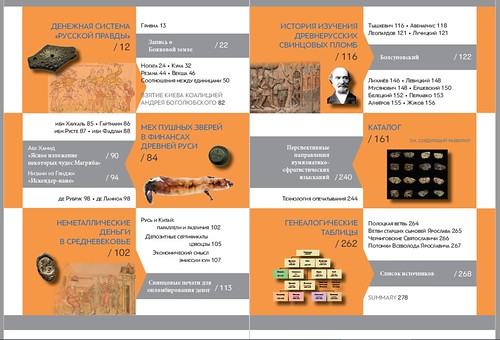
The book is written in a mixed genre. It is based on the research of Dzmitry Huletski, located at the junction of two auxiliary historical disciplines – numismatics and sigillography. Several years ago he started his research of unusual ancient artifacts – small medieval Russian lead seals. In spite of the fact that more than one and a half centuries have passed since their first recognition by Count K.P. Tyszkiewicz, no one has been able to explain their phenomenon sufficiently.
In the first part of the book we worked with medieval Russian written sources, comparing them with data from archeology and numismatics, studied the historiography of monetary systems of the pre-Mongol period of Russian history and developed our own vision of this problem. Monuments of the legal thought of Ancient Rus’ – the “Rus’ Justice”, princely statutes, international treaties – do not shed enough light on money circulation in ancient Rus’. They allow us to trace its features only in general outlines and in the individual territories of Novgorod and Smolensk. The Novgorod monetary system can be characterized somewhat more fully because of the significant number of contemporary birchbark letters found there. We can only use analogies to talk about how the markets of the remaining lands functioned.
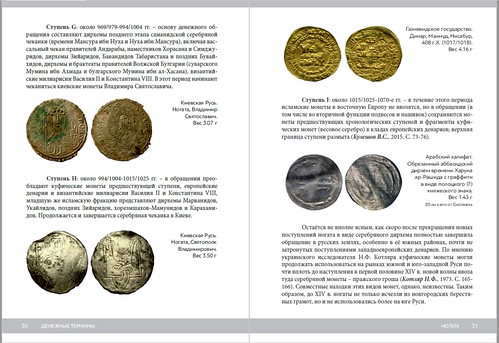
As the majority of modern researchers, we adopt the idea of circulation of fur money in the 11th-13th centuries in Rus’. It would be impossible to prove this without reliance on the testimonies of outstanding foreigners who visited Russia in the Middle Ages or heard about its customs from eyewitnesses. A second part of the book is devoted to a review of their rather sparse allusions. Roger Bacon directly compared Russian fur money with contemporary Chinese paper notes. It forced us to pay attention to the latter and learn the circumstances of their emergence and functioning. The third section is devoted to the financial side of the issue of fur valuables, after which the history of the appearance of small seals from lead is briefly considered.
The interrelation between the “kuna” of written sources (one of two main currency units of this time in Rus’) and medieval Russian lead seals, which now seems obvious to us, has determined the subject of the voluminous fourth section. It is dedicated to the historiography of the Russian “small sigillography”. Here all important studies, beginning from 1864, are mentioned.
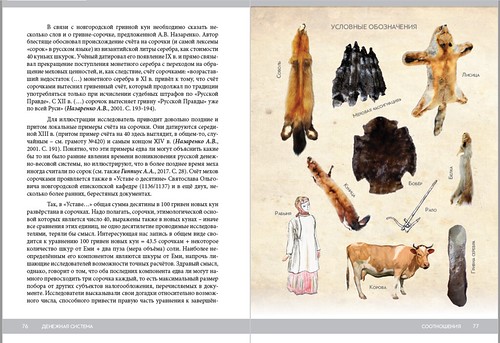
Finally, the fifth part is a catalog of small medieval Russian l lead seals containing 69 types and a number of their subtypes. It was compiled on the basis of eight publications of Dzmitry Huletski with co-authors and collaborators published from 2016-2018, in which he introduced more than 1,000 new finds of small seals. This catalog is far from being complete yet. The publication of many more thousands of seals will probably be required to complete the study of their emission in the pre-Mongol period. We hope this work will be an intermediate milestone that sums up our three-year study, but we don’t plan to stop here. In the sixth section we discuss several topics that, in our opinion, stand among the most promising directions for the research in Russian sigillography in the immediate future.
While preserving a scientific style in the main text of the book, we also devoted additional efforts to a selection of illustrative series, as well as to the creation of a reference tool that would help an inexperienced reader to navigate through the “pantheon” of medieval Russian historical personalities. Thus, the choice was made in favor of the popular scientific format of the publication. Images of the coins and seals are presented in this book in a 1.5x magnification.
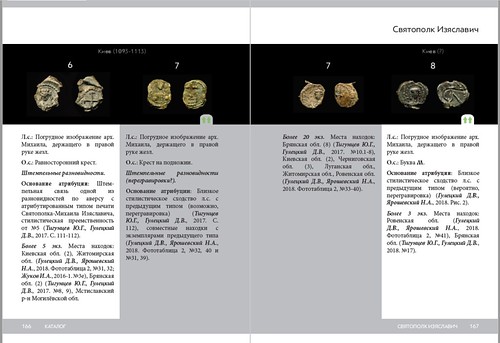
For more information, or to order, see:
FUR MONEY of Medieval Russia (11-13 cts). Catalogue (https://www.ebay.com/itm/192574188269)
To read or download a soft copy, see: Д.В. Гулецкий, Н.А. Дорошкевич. Меховые деньги Древней Руси. XI–XIII вв. (https://www.academia.edu/36835725/)
(https://www.academia.edu/36835725/)
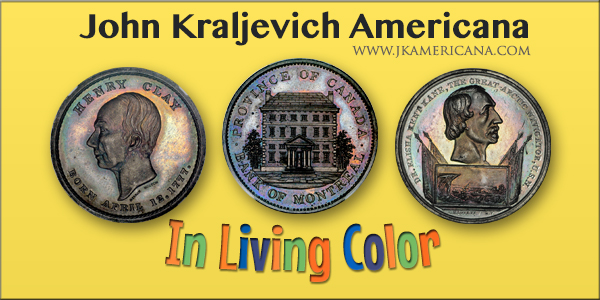
NEW BOOK: FRENCH SOUTHEAST ASIA COINS & CURRENCY
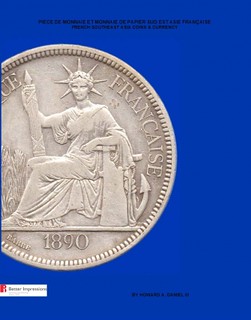 The Catalog and Guidebook of Southeast Asian Coins and Currency, Volume I, France
The Catalog and Guidebook of Southeast Asian Coins and Currency, Volume I, France
This catalog's second edition was published in 1978 and it took me only 40 years to collect enough new pieces, research enough new sources, and receive enough new images and data from many contributors to feel confident enough to create the third edition. No one person could have created the catalog and I am VERY thankful to the many contributors. Besides seeing them in the List of Contributors, you will see them mentioned under many of their images.
This book describes and catalogs the legal tender coins and paper money issued by the French in Southeast Asia from the early 19th century to 1955. This work is a comprehensive catalog of French Southeast Asia Coins and Currency covering:
French Cochinchina;
French Indochina;
French Protectorates of Cambodia, Tonkin, Annam, and Laos;
French Republic of Cochinchina;
French Kingdom of Cambodia;
French Kingdom of Laos;
French State of Viet Nam;
French in Siam (Thailand); and the
French in the Dutch East Indies
There are also other financial instruments such as treasury certificates, business and military tokens and scrip, postal pieces, Chinese and Japanese WWII occupation notes, Vietnamese anti-French bonds, and many other pieces. Many pieces have never been illustrated and/or cataloged in any other reference. Besides the detailed information for over 1000 pieces, there is also historical background information. All values are in US Dollars.
I had trouble attaining approval by the censors for my last catalog to print it in Viet Nam and I strongly believe they would not have approved this catalog so I had it printed in the USA. The printer, Better Impressions, in Sterling, Virginia matched the quality of my previous catalogs and he is interested in doing other numismatic catalogs. The printer is Michael Healy and he can be reached at Michael@BetterImpressions.com. It measures 7x10x6/8" so it is in a handy size to carry to a show.
This catalog is in full color and has the largest number of pages (296) than any of my previous catalogs and with over 1000 pieces. Not only does it have the expected French Cochinchina, French Indochina, French Cambodia, French Laos and French Viet Nam, but it also has Bank of Indochina notes and jetons issued in Siam (Thailand), and the French issues of coins and notes in the Dutch East Indies in the early 1800s. There are also some tokens from the French-owned plantations in the Dutch East Indies.
After the legal tender issues, there is a bullion chapter with silver and gold bullion ingots, rounds, and gold wafers. There is a small chapter on patterns, proofs and essais, which is followed by a much larger chapter on counterfeits, replicas and fantasies. There is a small chapter on medals but a reader can see many more of them by emailing me. The next chapter is for miscellaneous and has a large number of pieces like coin jewelry; a treasury gift certificate; lotteries; tram tickets; trade cards; a bill of sale; pension documents; Indian Hundis from Saigon; funeral money; treasury certificates; postal money orders; reply coupons; stamps used as money; bank exchanges and checks; stocks; bonds; business and utility tokens, scrip and checks; Sun Yat Sen bonds sold in the colony; Phan Boi Chau anti-French bonds; military tokens and scrip; Chinese notes used in northern Indochina in 1945-46; Japanese notes used in northern Indochina in 1940; French scrip for interned Japanese after WWII; and coin, note and medal boxes and holders.
There is an extensive bibliography; a French to English glossary; and an index. All of the values are in US dollars and most come from auction results and price lists. I do accumulate corrections from readers and myself and it is available by contacting me at P.O. Box 880067, Port Saint Lucie, FL 34988-0067 or HADANIEL3@MSN.COM.
It is sold by Wayne Herndon's Wizard Coin Supply at www.WizardCoinSupply.com and this catalog and others can be found by typing "Daniel" in the Search.
Binding: Paperback
Edition: 3rd
Publication Date: April 10, 2018
Size: 7x10
Pages: 296
For more information, or to order, see:
The Catalog and
Guidebook of Southeast Asian Coins and Currency, Volume I, France
(https://www.wizardcoinsupply.com/the-catalog-and-guidebook-of-southeast-asian-coins-and-currency-volume-i-france.html)
The Catalog and Guidebook of Southeast Asian Coins and Currency, Volume I, France is the first volume in a five volume, seven book series on Southeast Asia coins and currency by Howard Daniel III:
Volume 1 is French (The Catalog and Guidebook of Southeast Asian Coins and Currency, Volume I, France) currently in its third edition.
Volume 2 is Viet Nam in three parts: Part 1: Empire of Viet Nam (currently in progress) Part 2: Democratic Republic of Viet Nam Coins and Currency currently in its second edition. Part 3: Socialist Republic of Viet Nam Coins and Currency
Volume 3 is Cambodia (Cambodia Coins and Currency)
Volume 4 is Lao (Lao Coins and Currency)
Volume 5 will be Myanmar (Burma)
NEW BOOK: LES ENVELOPPES ROUGES (RED ENVELOPES)
In her latest Chinese Money Matters blog, Helen Wang of the British Museum reviewed a 2011 book on the topic of these colorful popular culture artifacts. Here's an excerpt - see the complete post online for the table of contents and other information. -Editor
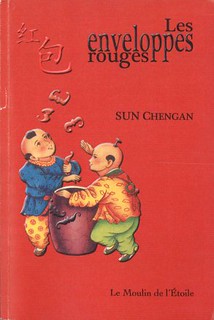 A few blogs back – no. 45 “Cultural Revolution Style Red Packets” – Lyce Jankowski left a comment, drawing my attention to Chengan SUN’s
work on red envelopes: a PhD and a book, titled Les enveloppes rouges: évolution et permanence des themes d’une image populaire chinoise (Le
Moulin de l’Etoile, 2011. ISBN 978-2-915428-37-7). A copy of this book has just arrived at the Dept of Coins and Medals, British Museum, and I’ll
outline the contents below.
A few blogs back – no. 45 “Cultural Revolution Style Red Packets” – Lyce Jankowski left a comment, drawing my attention to Chengan SUN’s
work on red envelopes: a PhD and a book, titled Les enveloppes rouges: évolution et permanence des themes d’une image populaire chinoise (Le
Moulin de l’Etoile, 2011. ISBN 978-2-915428-37-7). A copy of this book has just arrived at the Dept of Coins and Medals, British Museum, and I’ll
outline the contents below.
Almost 200 red envelopes are illustrated in the book, from the author’s collection of over 500 pieces.
Red envelopes, the development and permanence of themes in a Chinese popular imagery
Red envelopes are a particular kind of popular and ritual imagery in China. Their existence has been confirmed by the appearance before the 10th century of similar types of envelopes. They have always preserved an important social and political function concerning relations between generations and social classes.
Red envelopes have had a ritual importance in Confucian society which uses the Lunar calendar for social commemorations in a society predominantly based on agriculture. On the one hand, they maintain links between individuals for events or ceremonies concerning important social events such as births, weddings, birthdays or even professional promotions, acquiring a new flat, or a funeral. In addition, they are the expression of a classical tradition based on images and the recurrent expressions using four ideograms written on them.
Popular images such as those found in New Year’s prints and paper cuts have been of great importance, but in the last decade or so, this has been decreasing on the Mainland, but more so in Taiwan, in favour of humorous and ephemeral industrialized products, more in line with the testes of an urbanized society, where other commercial products (phone cards, labels, advertising) use similar themes.
To read the complete articles, see:
48. RED
ENVELOPES – THE DEVELOPMENT AND PERMANENCE OF THEMES IN CHINESE POPULAR IMAGERY
(https://chinesemoneymatters.wordpress.com/2018/06/21/48-red-envelopes-the-development-and-permanence-of-themes-in-chinese-popular-imagery/)
45. “CULTURAL REVOLUTION STYLE
(https://chinesemoneymatters.wordpress.com/2018/05/15/45-cultural-revolution-style-red-packets/)

NEW BOOK: SVERIGES RIKSBANK
David Sundman writes:
This page has a link to a PDF file of the booklet, which is in English. I collect Swedish notes and coins, including plate money. This publication provides a nice overview of the very complex changes the Swedish monetary system has had over the 350 plus years.
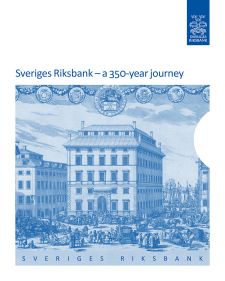 The publication "Sveriges Riksbank – a 350-year journey" gives us a retrospective of important events in the history of the
Riksbank up to today's date.
The publication "Sveriges Riksbank – a 350-year journey" gives us a retrospective of important events in the history of the
Riksbank up to today's date.
The publication contains the chapters:
• The unintentional central bank
• 350 years of defending the value of money
• The Riksbank as manager of financial crises
• Who shall decide over the Riksbank?
The author is Gunnar Wetterberg, historian and writer, and the main editor and co-author is Ann-Leena Mikiver, Director of Communication at the Riksbank.
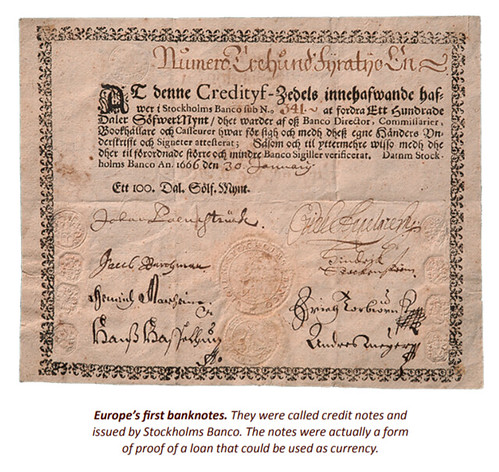
To read the book, see: https://www.riksbank.se/globalassets/media/riksbanken-350-ar/digital-skrift/sveriges-riksbank-a-350-year-jurney.pdf
To read the complete article, see:
The
publication “Sveriges Riksbank – a 350-year journey"
(https://www.riksbank.se/en-gb/about-the-riksbank/the-riksbank-350-years-old/the-publication-sveriges-riksbank--a-350-year-journey/)
NEW BOOK: COINS IN THE PELOPONNESE
Demetrius Siatras writes:
The long ago expected volume 10 of the series OBOLOS, published by the Friends of the Athens' Numismatic Museum , is now available ; it fills the gap in the series: 1-9 and 11-13 had already been published. The missing volume is published as a supplement of BCH, the archaeological journal of École française d'Athènes.
COINS IN THE PELOPONNESE =
LA MONNAIE DANS LE PÉLOPONNÈSE
By Eva Apostolou, Charles Doyen (eds.) p> Bulletin de Correspondance Hellénique Supplément 57 et Obolos 10
Athènes: École française d’Athènes, 2018. Papers in Greek, English, French. Two volumes. Soft cover, 19x24 cm, 528+288 pp., ill. ISBN: 978-2-86958-295-8.
EUR 88.00 + Shipping cost.
For more information, or to purchase, see:
COINS IN THE PELOPONNESE = LA MONNAIE DANS LE PÉLOPONNÈSE
(https://booksoncoins.blogspot.com/p/recently-published.html)

BOOK REVIEWS: ANCIENT COINS IMAGES, POMPEII
Greek and Roman Coins Seen Through Their Images
TYPOI
Greek and Roman Coins Seen Through Their Images
Noble Issuers, Humble Users?
Proceedings of the International Conference Organized by the Belgian and French Schools at Athens, 26-28 September 2012 par P.P. IOSSIF, Fr. DE CALLATAŸ, R. VEYMIERS (eds.)
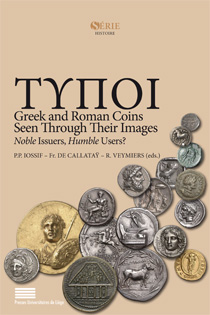 Since the 16th c. numerous studies have been consecrated to the images depicted on Greek and Roman coins. Most of them are concerned with
the identification of numismatic types. In contrast, rare are those asking questions about the possible mechanisms preceding the choice of types by
an authority and their reception(s) by different audiences. The present book brings together various approaches on visual culture from different
fields (working on different areas, periods, or specializing in media other than coins) proposing an original methodological synthesis of what has
been done or has still to be done in numismatic iconography.
Since the 16th c. numerous studies have been consecrated to the images depicted on Greek and Roman coins. Most of them are concerned with
the identification of numismatic types. In contrast, rare are those asking questions about the possible mechanisms preceding the choice of types by
an authority and their reception(s) by different audiences. The present book brings together various approaches on visual culture from different
fields (working on different areas, periods, or specializing in media other than coins) proposing an original methodological synthesis of what has
been done or has still to be done in numismatic iconography.
More precisely, this book explores the relation between “issuer” and “user” by addressing various points. Were numismatic types chosen and adapted for particular audiences? If so, then how is it that the iconography, bearing a religious character in most of the cases, does not correspond to those we imagine being the primary beneficiaries, i.e., soldiers and traders? What is the actual circulation of monetary images? What are the differences and similarities with respect to the images produced in other media of similar or distant sizes and qualities, gems and seals being similar, vases and sculptures being distant? To what extend did the issuers draw on media other than coinage for their iconographic ideas? Could users understand the “message” without the mediation of other media? In which way did numismatic imagery influence (or was it influenced by) the iconographic types and choices on other media? Which concepts and tools coming from different fields of research (anthropology for instance) are likely to help our understanding of the type-choice process? Are numismatic types over-commented by art historians (eager to use the term “propaganda”) and under-commented by economists (more imbued with pragmatism)? To what extent did the indispensable confidence of the users determine the use of images easily recognizable by them? Who decides the monetary iconography: the highest authorities or, as in the case of Republican Rome, junior aediles? Who’s responsible for the numismatic type: the coin engraver or the artist creating the original design? These are some of the questions addressed in this book and answered by leading specialists through new lenses and perspectives focusing on visual culture.
For more information, or to order, see:
http://www.presses.uliege.be/jcms/c_19852/typoi
To read the CoinsWeekly article, see:
How came images on ancient coins?
(http://www.coinsweekly.com/en/News/How-came-images-on-ancient-coins/4?&id=5447)
Rinvenimenti monetali e circolazione a Pompei
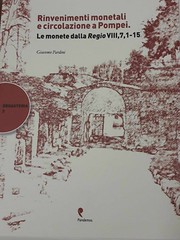 Giacomo Pardini
Giacomo Pardini
Rinvenimenti monetali e circolazione a Pompei.Le monete della regio VIII,7,1-15
ISBN 978-88-87744-77-4
ERGASTERIA è una collana di “Studi di Archeologia” del Dipartimento di Scienze del Patrimonio Culturale (Beni e Attività Culturali, Filosofi a, Fonti, Testi, Territorio)
For more information, or to order, see:
Ergasteria
7. Rinvenimenti monetali e circolazione a Pompei. Le monete della Regio VIII, 7,1-15
(http://www.pandemos.it/collana-ergasteria/ergasteria-7-rinvenimenti-monetali-e-circolazione-a-pompei-le-monete-della-regio-viii-7-1-15-detail.html)
To read the CoinsWeekly article, see:
Shedding light on coins from Pompeii
(http://www.coinsweekly.com/en/News/Shedding-light-on-coins-from-Pompeii/4?&id=5445)
2018 NATIONAL HISTORY DAY WINNER
 Category Awards
Category Awards
Junior Paper
First Place
Title: 17 Years: Developing the United States Coinage System
Student(s): Kellen Hoard
School: Kamiakin Middle School
Kirkland, Washington
From the early 1600s to the late 1700s the monetary system of the 13 colonies was so dysfunctional that basic transactions required cumbersome mathematical calculations, specialized almanacs, and extensive knowledge of foreign coinage weights, measures, and values. Once the Declaration of Independence was signed, one task of the Founding Fathers was to develop a coinage system and a mint for the new nation. Between 1776 and 1792, the process of developing a coinage system and a mint was rife with conflict and compromise within the government. The result of these 17 years was a reassertion of American sovereignty, a national mint, and a coinage standard that has lasted for hundreds of years.
The Money Before Independence (1607-1776)
The colonies’ initial financial problems were sparked by mercantilism, a European economic theory that was popular from the 1500s through the 1700s.
As the numismatic historian Pete Smith explained, “[m]ercantilist thought held that a nation’s wealth rose and fell in direct proportion to the
amount of physical gold and silver held within its boundaries.” Because of this, England refused to provide the colonies with coinage and prohibited
them from striking their own money. The lack of specie from the mother country forced the colonists to almost entirely depend on world coinage that
found its way to them through trade. While the most prevalent coins were the Spanish pistareen, Spanish dollar, and Portuguese 6,400 reis, researcher
Philip Mossman found that there had been 33 commonly circulating coins from more than six different countries.
For more information on National History Day, see:
https://www.nhd.org/
https://www.nhd.org//winners

SCIENTIFIC AMERICAN ON NEWMAN NUMISMATIC PORTAL
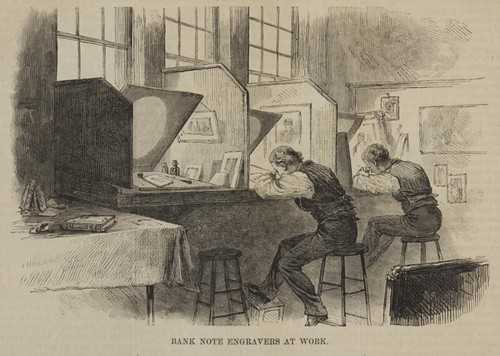
From: How Money Is Made, December 7, 1872
Scientific journal articles are on overlooked source of numismatic information. Craig Sholley and others have used sources such as the Journal of the Franklin Institute to shed light on various technical issues within numismatics. The Newman Portal has recently extracted articles from Scientific American dealing with coins and paper money, and these are now available on Newman Portal.
An article in April 1850 issue, for example, discusses the closure of the New Orleans Mint for administrative reasons – no one cared to apply for the open Treasurer position due to the lack of salary and the size of the bond required. Elsewhere, the February 1876 issue discussed protection of bank vaults. In total, approximately one hundred articles have been pulled and these provide an outsider’s view of American numismatics from an established and respected source.
There are several other periodicals with similar underutilized troves of numismatic information, if only someone could sort the wheat from the chaff. A few I can think of off the top of my head are:
Gentleman's Magazine
Historical Magazine
Harper's Weekly
Nearly any newspaper of course, has occasional numismatic articles as well. But what other periodicals or journals could we add to this list? Thanks. -Editor
Link to Scientific American on Newman Portal:
https://nnp.wustl.edu/library/publisherdetail/525611
STONE MOUNTAIN COMMEMORATIVE HALF RESEARCH
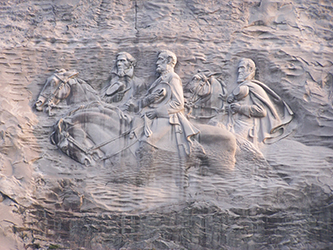
The carving on Stone Mountain is the largest relief carving in the world. It measures 90 feet tall by 190 feet wide, or 17,100 square feet. At its deepest, the relief is carved 42 feet into the rock face.
Gutzon Borglum, who went on to carve Mount Rushmore, had grandiose designs for more than the carving and envisioned a complex that included a memorial hall and reflecting pond leading up to the carving. This is not too different from his plans at Mount Rushmore which also had to be scaled back. He expected to carve the memorial hall into the mountain, and he had similar plans at Mount Rushmore. At Mount Rushmore he planned to house the Declaration of Independence and the Constitution.
Three figures on horseback featuring Jefferson Finis Davis, Robert Edward Lee, and Thomas Jonathan "Stonewall" Jackson make up the entirety of the sculpture. This is greatly reduced in size and complexity from the original concept by Gutzon Borglum. But after three attempts it is what was achievable balancing time, money, and effort.
The Stone Mountain Commemorative Half
Growing up in Georgia in the 1950’s and 1960’s I would travel with my father to Atlanta several times a year. Our route always took us along U.S. Highway 78 and thus we passed the unfinished carving on Stone Mountain twice on each trip. Neither of us thought the carving would ever be finished. It was just too massive and with two failures already it appeared to be someone’s pipe dream and the State’s nightmare.
By the time the carving project was restarted we were living elsewhere and it was not until we moved back to Atlanta in the mid-1970’s that we could appreciate the magnitude of the effort. Our family climbed the mountain on many Easter Sundays for sunrise services, and we lived close enough to visit the park on weekends with our children. So, for many the memories of the mountain have nothing to do with many of the discussions we have seen in recent months. But those discussions did spark some fresh interest in the Stone Mountain Half Dollar and the accompanying story.
Once we contacted other researchers and started to do our own investigation we realized that as a numismatist there was a lot to be learned. We also discovered that there is ample opportunity to contribute to the hobby through detailed research and examination of the coin. Our preferred method of presenting studies is to create a web site that will be a living, breathing work as more is understood and documented. This month we are launching a web site for that purpose at www.stonemountainhalf.com. We have no idea how long this study will last but based on similar work this will take years. Our early investigation has revealed some fascinating things that we will build on as we go.
There is a great story about the successes and failures of the attempts to create the carving that almost reads like a work of fiction.
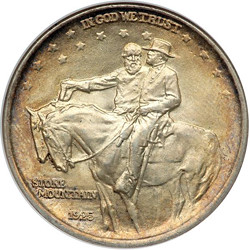

One interesting side note between the coin and the carving are the noticeable differences. On the completed carving the three riders have their hats covering their hearts, whereas on the coin Lee is wearing his hat. On the coin Jackson and Lee are in the lead with Davis completely out of the picture. These differences exist because of timing. The coin was struck to help raise money for the project and done early in the project when Borglum was still involved. His design made it to the coin and early items of exonumia, but not completely to the mountain.
The attempts to finance the carving produced a story all its own and created some of the rarest coin varieties (counterstamps) among all U.S. coins, many with a single known example and others that are documented but with no known examples
Stone Mountain Commemorative Half Research
It appears that the census of known counterstamped coins had not been updated since 1987 and we have already compiled an updated census that more
than doubles the previously documented coins http://www.stonemountainhalf.com/counterstampcensus.html
There is only one major DDO variety recognized by all the TPG’s, but we are identifying as many dies and minor varieties as possible, and there are many
No one has ever completed a full grading set nor documented the specific features by grade and we are well on our way to accomplishing this with 16 grades in our collection and more in the pipeline http://www.stonemountainhalf.com/ourcollection.html
Our Morgan Dollar experience has made us aware that to do a complete study hundreds of coins will be needed, so there will be excellent material at the end for anyone with an interest in this commemorative issue to study A by-product of any dedicated study is having all the coins under one roof with consistent visual documentation for other collectors to study. Having coins that cover the full range of grades and dies is paramount, so we are working with PCGS to have consistent high-quality images of every coin.
For each coin there is a dedicated research page with detailed notes and high-quality images denoting features of interest and die cracks. We have already received help from several others who have studied the Stone Mountain Half in some detail, so there is existing interest and knowledge to draw on in the study. To keep a conversation going we will use existing numismatic forums to publish new findings and gain insight into the knowledge of other collectors.
Our certified inventory on launch day is 48 coins, and we have more than 50 in the pipeline with a goal of 100 documented coins by year end. Our experience with other coin types has been that narrowly focused studies of a single coin often produce new and fascinating details for collectors. So, the adventure begins, and we hope this will spark interest in other collectors to do similar work.
To visit the web site, see: www.stonemountainhalf.com

The piece on the investment book is near and dear to my heart this week. I wrote the following in my President’s Letter to be published in the July issue of Penny-Wise. This is a short excerpt:
I have in my numismatic library a 1982 book entitled The Complete Investor’s Guide to Silver Dollar Investing by Dick A. Reed, who was a coin dealer in Phoenix, AZ. It may be of interest that back in those days, silver dollar dealers recognized only six MS price points: 60, 63, 64, 65, 67 and 69. They also recognized prooflikes in 63 and 65. The book then went on to predict the investment potential of each date and mintmark in each recognized grade level. Investment potential was given as percentage of return, annual simple interest. 1881-S in “investment grades” (MS-65-69) was predicted to increase at 20% per annum. According to Coin Dealer Newsletter, bid on 1881-S in MS-65 went from $87.50 in January to $110 in December of that year – a 25% gain, so maybe Mr. Reed was not living in a fantasy world at the time.
According to the Consumer Price Index (CPI) as published by the US government (https://www.bls.gov/cpi/tables/supplemental-files/historical-cpi-u-201803.pdf), the CPI is now 2.5 times that of 1982. If you had a coin worth $100 then, it would have to be worth $250 today to break even. By contrast, a $100 coin that appreciated 20% each year since 1982 would now be worth over $70,000! We know that didn’t happen to 1881-S Morgans or pretty much any other coin. As this is written the PCGS Price Guide lists MS-65 1881-S Morgans at $145 retail, more than in 1982, but well behind the CPI. However, we can’t even compare a MS-65 from 1982 to one today, as grading standards for Morgan dollars have changed substantially several times since then. In 1982, “MS-65” meant whatever the dealer said it meant, which is why we now have third party grading.
The letter does go on to show that "collector grade" early large cents have substantially out-performed “investment grade” silver during the period. This should surprise nobody.
To read the earlier E-Sylum article, see:
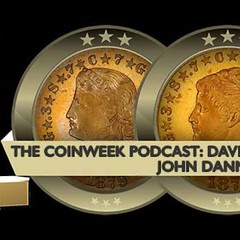 A little more than 30 years ago, a coin dealer from California and a close circle of his dealer friends bestowed new life upon the rare
coin industry with the introduction of a market-acceptable third-party grading service.
A little more than 30 years ago, a coin dealer from California and a close circle of his dealer friends bestowed new life upon the rare
coin industry with the introduction of a market-acceptable third-party grading service.
But there is far more to the story of the early days of PCGS than what you know, and the industry as we know it today was built because of and in spite of the ideas that went into the creation of the company.
We talk to two men who know more about it than anybody else: PCGS founders David Hall and John Dannreuther.
To read the complete article, see:

Punctuation on Coin Holders
Kenneth Spindler writes:
For the coin dealer I worked for, I wrote up many full PCGS submission sheets of coins that were to be denoted "Ex-Kings Norton Mint Collection." Kings Norton is the name of a place, where a metal company acquired minting machinery and struck coins on a contract basis for Great Britain and numerous other counties. Once the coins all came back with labels that said "Ex-King Norton's Mint Collection," like England had a King Norton at some point. Maybe he was related to San Francisco's Emperor Norton I.
Islamic Coin/Token identification Sought
Anne E. Bentley of the Massachusetts Historical Society writes:
We received a request for help in identifying this item. Although I lived in Saudi Arabia for two years, I never learned Arabic so told our researcher that some of your readers might be able to assist her in identifying it.
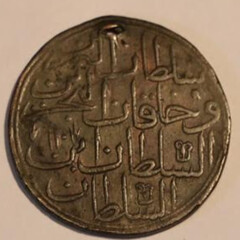
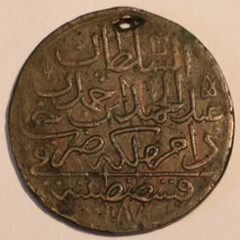
A Mystery Piece From Nepal
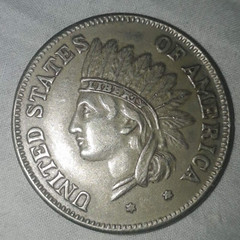
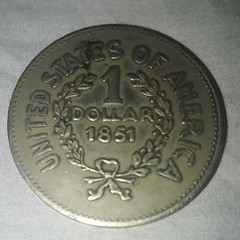
A web site visitor writes:
My name is Keshav Dhakal. I live in Pokhara City Nepal. It will be super helpful if you could help me with this coin. The size of the coin is 2.5 by 3.5 inches and it weight is 20 grams.

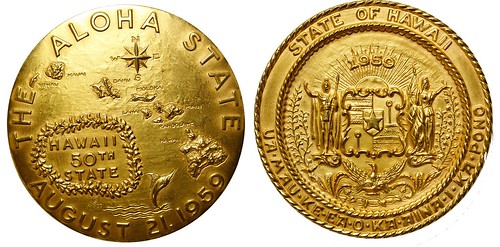
California sculptor Spero Anargyos (1915-2004) was commissioned to design and model the Hawaii Statehood Medal, Medallic Art Company catalog number 1959-092. His original model had one of the Hawaiian Islands misspelled. (I don’t remember which one.) The error was discovered after dies were made and an unknown number were struck and issued. Thus two varieties exist.
More than fifty gold medals were made. Numbers 3 through 53, 59, 69 and 100 were serially numbered according to company records. No record of number 1 and 2 exist, but these may have been presented to the governor at the time, James K. Kealoha, who also received 154 unnumbered silver. Three thousand serially numbered silver were issued, in addition to 29,599 unnumbered bronze. All medals were 2 1/2-inch (63mm) diameter.
Coin and Currency Institute of New York was the official distributor for the medal in U.S., the firm of Edward D. Sultan, Ltd. of Honolulu was the distributor for Hawaii.
The mintage figures are extremely high for a fine art medal, but it proved the popularity of the medal. This was evidence of the empathy the public had for statehood status.
To read the earlier E-Sylum article, see:

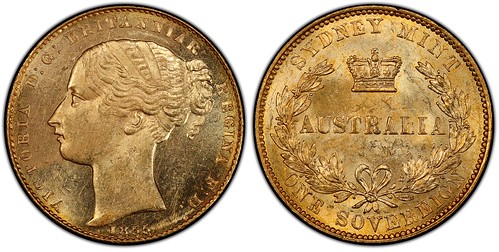
The finest known Australian 1855 Sydney Mint gold Sovereign, made during the first year of that mint’s operations, was discovered during the last expedition to the fabled “Ship of Gold,” the SS Central America, that sank while sailing to New York City in 1857.
Now graded PCGS MS62+, it is one of 82 sunken treasure world gold coins representing 10 different countries retrieved in 2014, recently cataloged by the California Gold Marketing Group and now certified by Professional Coin Grading Service.
“The 1855 Sydney Sovereign is the equivalent of the U.S. 1854-S Half Eagle; both ‘S’ mints, both first year of striking. It’s an amazing discovery,” stated Dwight Manley, managing partner of the California Gold Marketing Group. He compared the rarity and historical significance of the recovered Australian coin to one of only four known surviving 1854 $5 denomination gold coins made during the San Francisco Mint’s first year.

“An 1856 Sydney Mint Sovereign, now graded PCGS AU58 and even rarer than the 1855, also was found. Someone apparently traveled from Australia to the San Francisco area with the 1855 and 1856 gold coins,” Manley revealed.
“It is fascinating to think about how these coins got to San Francisco. Were they carried by an Aussie miner seeking his fortune during the California Gold Rush or acquired as winnings in a gold camp poker game? Those two coins were onboard when the SS Central America went down 161 years ago,” said Manley.
“The two Australian coins were found in the same area of the seabed more than 7,000 feet below the surface of the Atlantic Ocean off the coast of the Carolinas,” explained Bob Evans. He was the chief scientist on the 1980's missions that first located and recovered a portion of the fabulous SS Central America treasure and then assisted with the 2014 recovery.
“Communication, commerce, and travel between California and Australia were fully developed during the 1850s, in spite of the 7,500-mile steamship voyage required. The Australian Gold Rush that started in 1851 attracted a diverse, multi-national throng, quickly changing the demographics of the former penal colony. Many among the international crowd of gold-seekers visited both Australia and California seeking their fortunes,” explained Evans.
The vast majority of the more than 3,000 gold coins recovered in 2014 were struck in the United States. But the retrieved world gold coins represent an interesting mix of Latin American and European coinage in addition to the two Australian gold pieces.
Here are the countries and the number of recovered coins from each: Australia (2 coins); Bolivia (1); Federal Republic of Central America (1); Costa Rica (3); France (20); Great Britain (41); Mexico (5 including 3 contemporary counterfeits), Netherlands (6); Peru (2); and Spain (1).
Among the other notable world coins recovered in 2014 and now cataloged are:
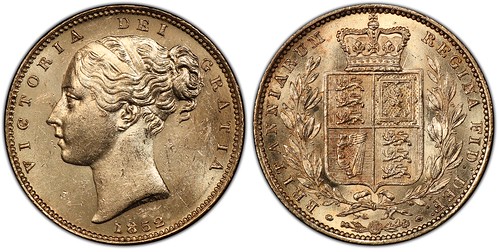
Great Britain 1852 Queen Victoria Sovereign with Arabic 1, PCGS MS63+; Great Britain 1855 Queen Victoria Sovereign, PCGS MS62; and two Great Britain 1856 Queen Victoria Sovereigns, one graded PCGS MS62, the other PCGS MS61.
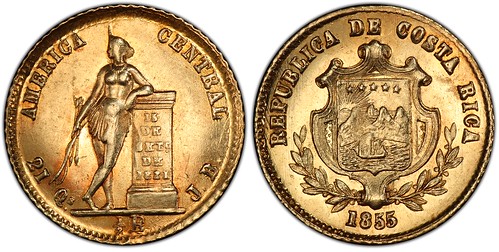

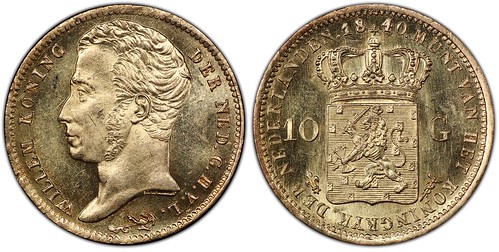
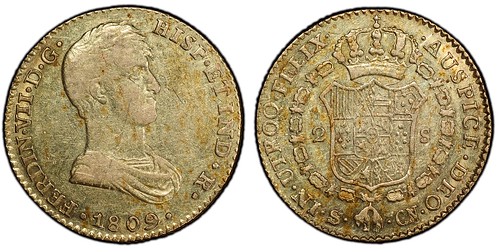
Also now certified are Costa Rica 1855 JB 1/2 Escudo, PCGS MS63; France 1854-A Napoleon III 5 Francs, PCGS MS61 and France 1855-A Napoleon III 20 Francs, PCGS MS61; Mexico 1852-Go 8 Escudos, PCGS MS61; Netherlands 1840 (u) King Willem I 10 Gulden, PCGS MS63+; and Spain King Ferdinand VII 1809-S Draped Bust 2 Escudos, PCGS AU50, the oldest-dated gold piece recovered from the famous ship.
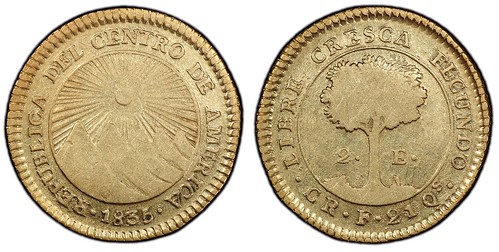
“It’s kismet that one of the recovered coins from the SS Central America, an 1835 2 Escudos, was from the Central America Republic,” said Manley.
The Federal Republic of Central America was a sovereign state between 1823 and 1841 comprising at times part of what is now Costa Rica, El Salvador, Guatemala, Honduras, southern Mexico and Nicaragua.
Each of the PCGS-certified world coins now is encapsulated in specially-produced and labeled holders that contain a pinch of recovered SS Central America gold dust in a separate compartment. The insert label includes a statement of authenticity hand-signed by Evans.
In the coming weeks, additional highlights of the recently examined and certified treasure will be revealed. A complete inventory of U.S. and world coins and assayers' ingots recovered in 2014 will be listed in an upcoming book, America’s Greatest Treasure Ship: The SS Central America, The Second Journey, by Q. David Bowers and Manley. It will be published by the California Gold Marketing Group later this year.
Why were there dozens of world coins on the ship? Bowers explained: “In San Francisco in 1857 all sorts of foreign gold coins were legal tender. Back then, the Australian Sovereigns and the other recovered gold coins were not of any particular notice or importance, but today they are numismatic treasures!”
The SS Central America was a 280-foot long, three-masted side-wheel steamship carrying tons of California gold that had been shipped from San Francisco to Panama when she sank in a September 1857 hurricane during a voyage from Aspinwall (now Colón), Panama to New York City. The loss of the gold cargo was a major factor in the economically devastating financial panic of 1857 in the United States.
The California Gold Marketing Group LLC of Brea, California acquired the 2014 treasure from Ira Owen Kane, Receiver for Recovery Limited Partnership and Columbus Exploration, LLC in a court-approved transaction in November 2017. In 1999, the group acquired all of the available treasure that was recovered in the 1980s.
To read earlier E-Sylum articles, see:
BOB EVANS REVEALS LATEST SS CENTRAL AMERICA DISCOVERIES (http://www.coinbooks.org/esylum_v17n43a13.html)
VIDEO: IN DEEP WATER: FINDING THE SS CENTRAL AMERICA (http://www.coinbooks.org/v20/esylum_v20n45a30.html) THE S.S. CENTRAL AMERICA'S LOST MINT DOCUMENTS
In 1857-1858, after the S.S. Central America foundered in a hurricane off the Carolinas on September 12th, the Director of the United States Mint, James Ross Snowden, and the San Francisco Branch Mint Superintendent Charles H. Hempstead exchanged several letters which in part cited the wreck. The main focus of their discussion revolved around handwritten copies of key San Francisco Branch Mint records that were lost with the ship.
The date of August 20th referred to in the letter excerpts, marked the morning that the steamship S.S. Sonora departed from her berth in San Francisco Bay and headed down to Panama. Her valuable cargo included over 400 passengers, the twice-monthly California gold treasure shipment and mail bags. The first leg of the passage by sea ended with a quick trip ashore and a crossing by light rail from the Pacific side of the Isthmus to Aspinwall on the Caribbean Sea where the S.S. Central America lay in wait for the voyage back to New York.
The Melter & Refiner cited in the letters was Agoston Haraszthy who was accused of a $152,000 shortfall of gold in the Branch Mint's account books.
The following excerpts are from Snowden writing to Hempstead.
Mint of the United States
Philadelphia Sept. 19th, 1857
Sir:
“You have doubtless written to me by the mail which was on board the steamship “Central America”. We have the awful news of the loss of this ship at
sea and of a large portion of the passengers, and the treasure on board as well all the Mail Bags.
I had expected by this steamer to receive your final report of the conclusion of the settlement of the late Melter & Refiner's account, and also the estimates for the next fiscal year.
In case your reports came forward by the last mail (viz. 20th ultimo.). I have to request that you will send me duplicates (if not already done) by the earliest opportunity...”
The Bullion Fund cited in the following correspondence gave the Branch Mint the power of paying coin to its depositors as soon as the value of their gold deposits were determined by assay. This was critical in California's high interest rate environment, where wasted time was lost money. Most miners, merchants and bankers in need of coin on the exigencies of steamer day could not afford to wait while their gold deposits sat in line waiting to be coined. Funded by the U.S. Treasury, the Bullion Fund was withdrawn during the financial crisis of 1857.
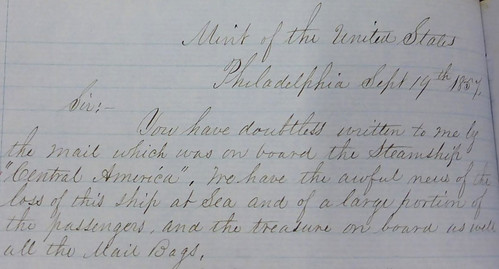
Mint of the United States
Philadelphia October 6 th , 1857
Sir:
“In your last letter you refer to certain statements, accounts & c. forwarded to me by the preceding mail (viz. that of the 20th of August last).
As the mail was lost at sea, I am not in possession of the details of the deficiency in the Bullion Fund of your branch referred to in your letter of
the 4th ultimo., you also speak of the accounts of the late Melter & Refiner having been closed prior to forwarding of your letter by the mail of
20th August last. From this remark I infer that an official account of the settlement and statement of the precise amount of the deficit of the late
Melter & Refiner was mailed to me on the 20th of August last. In my communication of the 19th ultimo. I informed you of the great calamity that
had befallen the steamship “Central America” and the loss of the mail bags & c and requested you to forward me duplicates of all the papers
addressed to me by that mail. The receipt of these duplicates is looked for with much anxiety, and I trust that the records of your office will
enable you to supply them without much trouble...”
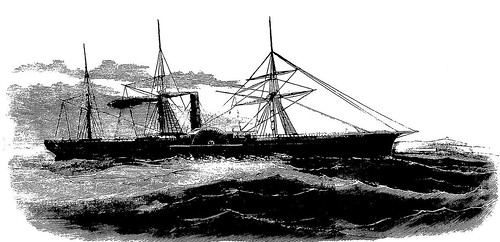
Mint of the United States
Philadelphia December 4 th , 1857
Sir
“I have to acknowledge the receipt of your favor of the 4th ultimo. with the enclosures stated and a package containing the assay coins of your
Branch Mint, reserved from the coinage of October, also duplicates of certain documents forwarded by the steamer “Central America”...”
“It is greatly to be regretted that the accounts forwarded by the “Central America” have been lost . The manner in which you propose to supply them is all that can be done; the employment of an additional temporary clerk is certainly proper...”

Mint of the United States
Philadelphia Jan. 4 th , 1858
Sir:
...“As regards the extra compensation claimed by the clerks you name for services in preparing duplicates of the papers lost with the "Central
America" I make the general remark that under repeated decisions of the Department such allowances cannot be made to persons in the service of
the government whose compensation is fixed by law. If I had any doubts on this subject I would refer it to the Department; but the present Secretary
of the Treasury as I know decided this point in the way I have indicated....
The fact you notice of finding gold in the rubbish carted from the Branch Mint is very remarkable, and indeed startling. But Mr. Haraszthy's operations were of such a character as to prepare one for almost anything. I therefore am not surprised. It shows gross carelessness or something worse.
The accounts of your Branch Mint for the 2nd & 3rd quarter of 1857 (lost with the steamer “Central America”) are in course of examination here (at the request of the auditor) preparatory to their transmission to Washington.
I may state that a subpoena was served on me recently to attend the trial of Mr. Haraszthy on the part of the defendant, and bring certain papers with me. Of course I cannot respond personally to the subpoena, but by next mail I will forward to you the papers asked for and request you to hand them to the court.”
Very Respectfully
James Ross Snowden
Director of the Mint
Charles H. Hempstead Esq.
Supt. Br Mint
San Francisco
Cal.
As Robert Leonard pointed out to the author, the mint was churning out a million dollars or more in gold coins every month. Yet they refused to pay overtime to the clerks hired to reproduce the important Branch Mint records lost in a tragedy.
In the end, it was found that Haraszthy did not owe the government a single cent. The bulk of the Mint's losses had occurred by running the Refinery day and night to satisfy depositor demand. Under this heavy work load, fine gold was being drawn up the Refineries chimneys and settling on the Branch Mint's roof and the roof tops of nearby buildings.
Harazthy went on to become a famed agriculturalist in California with extensive vineyards under his watch. He passed away in 1869 in Central America, believed to have been snatched by an alligator from the bank of a river in Nicaragua or perhaps he drowned. His body was never found and may have simply been washed out to sea.
Dan Owens adds:
The 2nd and 3rd quarter San Francisco Branch Mint accounts must have been re-copied by the SFBM clerks and successfully re-sent to Philadelphia on another steamer. Also see the December 4, 1857 letter acknowledging receipt of duplicates of certain documents.
THE BOOK BAZARRE
So what do they have to do with numismatics? You're about to find out. -Editor
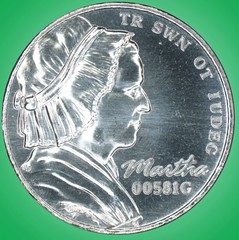
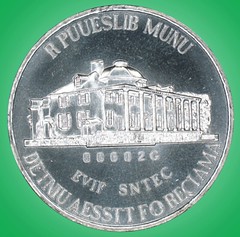
When designing a new coin, U.S. government agencies such as NIST use a "dummy" imprint so as not to run afoul of anti-counterfeiting rules. Here, Martha Washington in a mob cap subs in for Thomas Jefferson.
Nickels are ubiquitous in American life, tumbling around in pockets, rolling under car seats, and emerging from the back of dryers to be used over and over for countless purchases. But these resilient and somewhat humble-looking coins are also becoming costly to produce. Nickel, the coin’s own namesake, has become a prized ingredient in many modern products, pushing the market value so much that sometimes making the five-cent coin costs as much as seven cents a pop.
Working in conjunction with the U.S. Mint, a research team at the National Institute of Standards and Technology (NIST) has identified an alternative approach that would reduce the cost of materials for the nickel by as much as 40 percent. This approach would produce a coin every bit as tough and reliable as the old nickel but also every bit as familiar to the American citizen.
The paper that details the work was published today in the journal Integrating Materials and Manufacturing Innovation.
As an added benefit, the data from this research has also produced results that may aid high-tech companies looking for new materials to use in resilient electronics such as phones and laptops, and in a variety of radical new colors, to boot.
The manufacturing of coins is a complicated and demanding process. Coins must not corrode in the palm of a moist hand, for example. The images stamped on their faces must be resilient enough to withstand decades of commerce and the occasional turn through the laundry. Their metallic sheen must always be recognizable, and of uniform thickness and density.
Although invisible to the average customer buying a gumball or a soda, all U.S. coins must also contain a predetermined amount of electrical conductivity to work in vending machines, which use a small meter to determine a coin’s currency signature. A parking meter or soda machine won’t count your nickel without this key characteristic.
In many ways the nickel-production challenge was an ideal match for the NIST Materials Genome Initiative (MGI), which was started in 2011 with the ambitious goal of decreasing the time it takes a new material to reach market by at least half while keeping costs low. The MGI has been building the computational and IT tools needed for the development of all kinds of new materials for use in a wide variety of manufacturing applications.
“Rethinking the nickel was one of the first times we were able to deploy the new MGI tools to design a material for a specific application,” said NIST scientist Carelyn Campbell. “We were very pleased with the results.”
The NIST team worked backward, first identifying the desired qualities for the new nickel piece and then figuring out what alloys and procedures might be needed to make it a reality. The U.S. Mint also outlined some site-specific constraints; namely, the new coin had to be produced using the existing manufacturing facilities in Denver and Philadelphia, both of which use a specific type of slow-cooling procedure.
Color proved particularly challenging. Although most people would not think of the coin as having a special tone or hue, coin collectors are a demanding group and will often reject coins that are even slightly off-tone, and collectors form a significant share of the market for money pieces. The general public also might not trust a coin that is too orange or too yellow. But color is often a subjective criterion, and one that can be hard to quantify or reproduce with any kind of reliable standard.
In this case, the use of the MGI process proved enormously helpful—surprising even the researchers themselves with how efficient the outcome was. Starting with the set of parameters for resilience, conductivity and color, the team was able to produce a new mix of copper, nickel and zinc that was 40 percent less expensive than the previous metal mix.
The results could potentially save the U.S. Mint millions. In addition, several companies that manufacture high-tech items have shown an interest in the results, since there’s a strong consumer demand for electronics that are durable but also available in a variety of colors such as metallic pink.
No word yet on whether anyone is actively pursuing a phone that can make it through a turn in a hot dryer on laundry day, though.
To read the complete article, see:
Topic. The grouping of similar collectible items that form the limits of a collection. A topic is obvious if it is a well-defined subject category, as aviation, or space, or expositions, or Masonic, or music. But a collector defines his own topic – it is whatever he or she says it is. Often it is a very personal category, as objects of his ethnic background, of his religious heritage, of his professional vocation, or of other avocation, or curious interest. It is the bounds within which he would gather any item for his collection he feels is congruent or relevant to that subject.
Collectors of medals and tokens have about 350 well defined topics. This is well below the number of topics in other collectible fields, as stamps or postcards, but more than, perhaps, manuscripts or autographs. A collector can choose a broad topic (British Empire coins and medals), or a very narrow topic (as the medals of one subject in one locale during a brief time).
An important criteria for a collector choosing a new topic is: Does it turn you on? Is it of such permanent interest to you that you are willing to sustain an interest in it for a period of time? If the subject matter will give you pleasure in learning more about it and studying its objects, people and history then it is ideal choice. If it does not sustain this long-term interest, then it will not become a satisfactory topic for collecting.
Many professional people choose to collect medals of their profession, as a doctor collecting medical medals, a fireman collecting firefighting medals, and such. There is good reason for this. The more information you can bring to a topic, the more you will get out of it. Also, it will become a source of more knowledge and insight into that subject. A topic becomes a two-way road for the collecting specialist to become a better professional in addition to becoming a more knowledgeable collector.
Coins are collected mostly by country and denomination without too much regard to a topical interest. Medals and tokens, on the other hand, are virtually always collected by a topic. Thus a list of medal and token topics is fairly important.. However any individual can form a new collecting topic outside these defined bounds. After all, a collector can collect anything he so chooses and define his topic as he so wishes.
Note The author compiled a list of all topics and arranged them in a systematic order with the MAT CODE for (Medals And Tokens). In this scheme the topics were assigned a four digit number with open numbers for any future topics. There is an entry in this encyclopedia under that name.
Choosing a Topic. Hints in choosing a topic are:
1) Pick a subject you already know something about.
2) Pick a topic that turns you on – that greatly interests you!
3) Try to pick a topic that not everyone else is collecting; this will be less competition in obtaining specimens and you can find pleasure in a more selective territory.
4) At first pick several topics; collect from two to six topics to start. After a while one will become your favorite that you can concentrate on it to become a “first love.” You may wish to sell some of the items no longer of interest to you so these funds can underwrite purchases of items that are your most ardent desire.
5) If no topic seems apparent to you at first, then collect your own, or a favorite nationality; collectors in the U.S. have a wide selection of Americana.
6) If you have the inclination to write, you might want to catalog your collection for publication. Have each specimen photographed or scanned and write the description and research its history. Gather all the facts about it.
7) Seek out other collectors of your topic. Not only will you enjoy the camaraderie of a fellow collector – and the trading of duplicates – you
are helping to establish a base for the market of your topic. When your collection comes on the market, or you wish to donate it, other collectors
would be helpful to establish a market value, appraisal, or potential customers for the sale of pieces from your collection.
CLASS 13.1
Looking for the meaning of a numismatic word, or the description of a term? Try the Newman Numismatic Portal's Numismatic Dictionary at:
https://nnp.wustl.edu/library/dictionaryOr if you would like a printed copy of the complete Encyclopedia, it is available. There are 1,854 terms, on 678 pages, in The Encyclopedia of Coin and Medal Technology. Even running two a week would require more than 19 years to publish them all. If you would like an advance draft of this vital reference work it may be obtained from the author for your check of $50 sent postpaid. Dick Johnson, 139 Thompson Drive, Torrington, CT 06790.
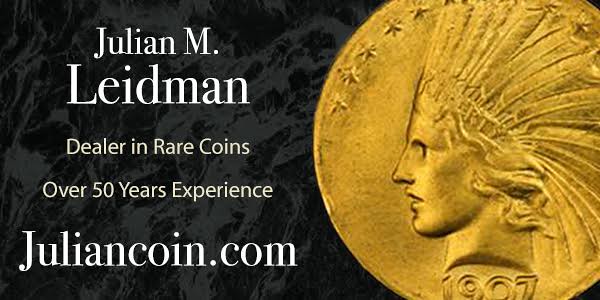
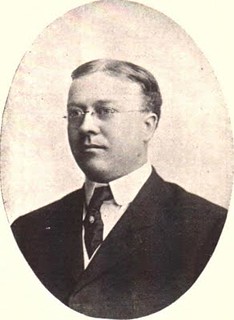 Moore was a prolific contributor to The Numismatist publishing over 130 articles largely on paper money and tokens, and composed
dozens of poems.
Moore was a prolific contributor to The Numismatist publishing over 130 articles largely on paper money and tokens, and composed
dozens of poems.
Waldo Clifton Moore (1874-1953), was born on July 23, 1874, at West Baltimore (now Verona), Preble County, Ohio, son and eldest of five children of John W. Moore (1850-1897), a native of Maryland of English-Dutch descent engaged as a building contractor, and his wife Mary Elizabeth Schnorf Moore (1856-1940), of German descent.
He had worked on his family 200 acre farm "Clifmore" so named after the two families Clifton and Moore. The farm was a noted chicken farm in its day for raising Orpington breed stock hens. Moore went to the local Harrison township public schools passing with highest honors the Boxwell Exam and became certified to teach in several counties. He graduated from the Dayton Normal School, and also from Dayton Commercial College.
In 1894, he attended the National Normal University, Lebanon, Ohio.
After passing the Civil Service Exams he was certified as a bookkeeper. He began teaching for six years and was promoted to principal at the Ithaca Normal School, Ithaca, Ohio. He resigned in 1899 taking a post at the Peoples Banking Company.
There he served a cashier at the Peoples Banking Company. His numismatic and philatelic interests grew into a passion for collecting memorabilia relating to Ohio. Moore is best known as a scrip collector specializing in Ohioan scrip, broken bank bills, shinplasters and bank and sutler's checks, campaign buttons, medals, autographs, and shells. He also was a specialist in Civil War tokens and store cards.
In 1907, Moore issued a store card with the obverse legend MOORE"S HENNERY, LEWISBURG, O./WHITE/ORPINGTON/STOCK/1907 - Reverse : CURRENT/FOR/ONE BIT/IN /EXCHANGE. The store card was a cash value token in exchange for twenty-five cents towards purchases of hens or eggs.
In 1911, he issued his own store card with a rebus on the obverse Awl + Tea + Hat + G [Cleft] + litters [hogs and hounds] + II [= two i's = is] knot + gold doubloon. "All that glitters is not gold" and legend on the reverse WALDO C. MOORE/A.N.A. 637/LEWISBURG, O./BANKER/NUMISMATIST/PHILATELIST/FOWL FANCIER/1911.
In 1912, he was appointed by President Taft to the U. S. Assay Commission.
From 1912 - 1917, Moore served as the General Secretary of the ANA.
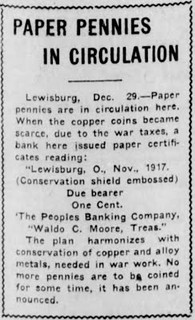 From 1917 to 1919 he served on the ANA Board of Governors.
From 1917 to 1919 he served on the ANA Board of Governors.
From 1919-1921 he served as the thirteenth president of the ANA.
In 1922, Moore became ANA Life Member No. 7.
In 1924, Moore served on the ANA Board of Directors.
In 1934, he retired from the Peoples Banking Company.
On January 5, 1935, Milfred Henry Bolender, Sale #94, auctioned a portion of the Moore collection. This sale took place the day following the death of Henry Chapman, Jr.
He died on Saturday morning, January 24, 1953, at his home after a long illness. He is buried at Roselawn Cemetery, Lewisburg, Preble County, Ohio.
The large hoard of Moore's scrip collection was inherited by family members who had no understanding of it or its value. It became broken up into parcels and either stored away or sold to private dealers and collectors decades later.
In 1972, Moore was inducted into the ANA Hall of Fame.
To read the complete article, see:
The entire inventory of the Lupia Numismatic Library is for sale. Individual items will be available before the remaining archives are broken up into parcels sold at philatelic auctions in the U. S. and Hong Kong. Check
NumismaticMall.com frequently as dozens of new items with estimates will be posted daily until everything is sold.All inquiries will be given prompt and courteous attention. Write to:
john@numismaticmall.com . THE RISE AND FALL OF BRUCE MCNALL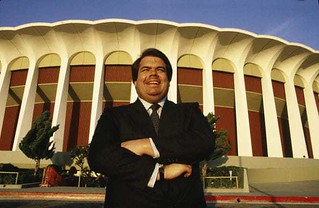 On Aug. 9, 1988, the hockey world changed forever. The Edmonton Oilers traded the Great One, Wayne Gretzky, along with Marty McSorley and
Mike Krushelnyski, to the Los Angeles Kings in exchange for Jimmy Carson, Martin Gelinas, $15 million in cash, and the Kings’ first-round draft picks
in 1989, 1991 and 1993. Behind all of this madness was young 38-year-old Hollywood movie producer and Kings owner Bruce McNall.
On Aug. 9, 1988, the hockey world changed forever. The Edmonton Oilers traded the Great One, Wayne Gretzky, along with Marty McSorley and
Mike Krushelnyski, to the Los Angeles Kings in exchange for Jimmy Carson, Martin Gelinas, $15 million in cash, and the Kings’ first-round draft picks
in 1989, 1991 and 1993. Behind all of this madness was young 38-year-old Hollywood movie producer and Kings owner Bruce McNall.
Growing up in Arcadia, California, McNall had interest in collecting ancient coins and artifacts. He claimed to be a child prodigy, starting college at 16 and attending Oxford. He was able to turn his childhood hobby and expertise into his first fortune. McNall had a gift of convincing wealthy people to buy ancient coins.
The McNall Rise
McNall now had a fortune that he made in the ancient coin collecting business. He soon ventured into horse racing and then into the movie business.
As a producer, McNall was responsible for producing movies like War Games and the cult classic Weekend at Bernie’s in 1989. Now, with his wealth and
celebrity status rising, McNall had his sights set on owning a sports franchise.
The young, charismatic McNall was now hanging around the Great Western Forum, soon becoming a celebrity in Los Angeles. During this time the Kings were owned by the late Dr. Jerry Buss. In 1979, Buss purchased the Kings, the Lakers and the Forum from Toronto radio mogul Jack Kent Cooke. Hockey, at the time, was an extremely tough sell in Southern California. Buss had no interest in hockey either. Regardless, McNall wanted a piece of the action. In 1986, he bought 25% stake in the franchise. The next year, McNall bought 24% more of the Kings, making him the largest shareholder of the team. Then, in 1988, he became the owner outright.
Everything soon started to take off for McNall. He now was living his dream to own a sports franchise in his hometown. Through the peak of his wealth, he now owned a rare copy of a Honus Wagner baseball card. He also was part owner of the Toronto Argonauts of the Canadian Football League with his friend, the late great comedian John Candy. Bruce McNall was on top of the world. With his wealth and fame aside, he is remembered more for being the owner that lured the Great One, Wayne Gretzky, out of Canada, and is remembered for making hockey cool in Southern California.
The Fall of Bruce McNall With this impressive resume, one would think Bruce McNall would end up in the Hockey Hall of Fame as a builder. Unfortunately, Bruce got into some trouble with the law. He defaulted on a $90 million loan and Bank of America threatened to force the Kings into bankruptcy if the team was not sold. The team had some tough years after that, and Gretzky was eventually traded to the St. Louis Blues.
McNall’s $200 million empire that he built through bank fraud crumbled. His days of driving fast cars and flying around in private jets were over. The glitz and glamour of the Hollywood lifestyle were long gone. In 1994, McNall pleaded guilty to two counts of bank fraud and single counts of conspiracy and wire fraud. McNall spent 70 months in jail and still owes the banks. On top of this, McNall admitted to smuggling ancient artifacts into the United States. His claim that he attended Oxford was not true either. McNall was released from prison in 2001.
McNall’s Impact on Hockey
Even with Bruce McNall’s legal issues, it is impossible to ignore the impact that he had on the NHL and the game of hockey. Before he became an NHL
owner, the only team in the United States that was west of St. Louis were the Kings. Now, the league has teams in cities that were once considered
non-hockey markets. Talented young players are coming from Texas, Florida, Arizona, Tennessee, and California. McNall’s influence on the game made
hockey no longer a regional sport in the United States.
To read the complete article, see:

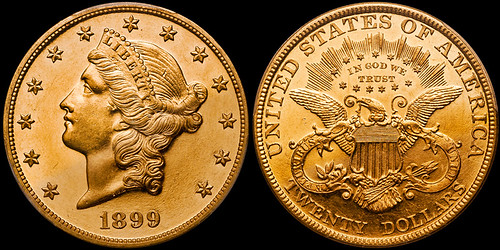
I’ve always been a keen student of numismatic history and I remain fascinated by collectors and their collections.
In the field of rare gold collecting, the Eliasberg pedigree tends to stand out over all others and I have had the good fortune of handling dozens of important US gold coins which trace their origin to the October 1982 sale.
There are standard Eliasberg coins, and then there are there are the uber-pedigreed coins from the Clapp/Eliasberg collections. These tend to be the best coins in the collections and they often trace their origin back to the 1890’s/early 1900’s when John Clapp Sr. was active. Clapp was the most sophisticated numismatist of his era, making amazing purchases which wouldn’t be fully appreciated for generations. I have a special fondness for these coins, especially when Clapp Sr. bought them from famous Chapman sales or—better yet—directly from the Mint.
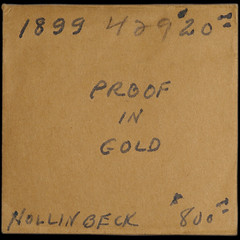 While a famous pedigree is always of interest to me, a less famous pedigree can be interesting as well. I recently purchased a pair of
PR63+ Liberty Head double eagles from a group of coins which had been off the market since the 1940’s. While the owner wasn’t famous, his old coin
envelopes (which accompanied the coins) with their handwritten notes from the era were charming and excited me when I bought—and sold—them.
While a famous pedigree is always of interest to me, a less famous pedigree can be interesting as well. I recently purchased a pair of
PR63+ Liberty Head double eagles from a group of coins which had been off the market since the 1940’s. While the owner wasn’t famous, his old coin
envelopes (which accompanied the coins) with their handwritten notes from the era were charming and excited me when I bought—and sold—them.
To read the complete article, see:

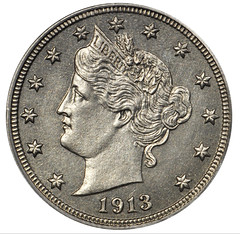
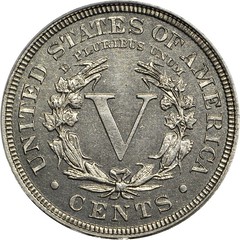
In the late 1980s, William Morton-Smith, a Santa Barbara, Calif.-based doctor, was rummaging through a garage that contained some of his deceased parents’ belongings. He opened the drawer of an old desk, and “there was a bunch of loose coins,” says Morton-Smith’s son, Tim.
Most people, when confronted with a pile of change, would simply put the coins in their pocket and forget about it. But “luckily,” Morton Smith says, “my dad had some wits about him, enough to realize they could be worth something.”
To be fair, Morton-Smith had a tip-off: The desk had belonged to his grandfather William Spaulding, the scion of a Boston Brahmin family whose wealth came primarily from sugar refineries. Together with his brother John, Spaulding was one of the wealthiest men in New England.
The Spauldings were prolific art collectors, and their 1921 donation of more than 6,000 Japanese prints to the Museum of Fine Arts in Boston represents a significant cornerstone of the institution’s collection.
“But no one ever knew of any reference to coins,” says Morton-Smith.
Not long after his discovery back in the 1980s, Morton-Smith’s father began an investigation into the coin’s origins. What he found inspired him to keep hunting for more rare monetary units; the result is one of the most significant numismatic collections in the U.S.
“My dad had a thing for coins, prior to discovering the drawer,” his son says, “but that really kicked off his interest. It triggered a modern-day treasure hunt, where he peeled back the history of the coins.”
At the time of his death in 2016, Morton-Smith had amassed a set of coins whose value Brian Kendrella, the president of the coin auctioneer Stack’s Bowers Galleries, estimates at $10 million. “Dr. Morton-Smith was definitely a collector, but he was also—and I hate this term, but I’m going to use it—a trophy hunter,” says Kendrella. “He just bought spectacular pieces.”
The drawer contained colonial cents, half-cents, and most prominent, an almost-complete set of Liberty Head nickels. The coins were made from 1883 to 1912 and depict Lady Liberty on one side and a V, the roman numeral for 5, on the other.
The set, which is worth about $100,000, was missing a piece that would elevate its value to the millions: a rare 1913 version of the coin that was struck by the United States Mint before its run of Liberty Head nickels was canceled. “Since it was discovered, it’s been one of the most sought-after coins in the United States,” says Kendrella.
After more than two decades, Morton-Smith finally completed his grandfather’s collection by purchasing one of those three nickels— the so called “Eliasberg Nickel,” named after its onetime owner, collector Louis Eliasberg, for a reported $5 million in 2007.
Now, as his children auction off the estate, that single 1913 nickel will come to auction at Stack’s Bowers in Philadelphia in August. (The children will not sell all of the set, for sentimental reasons.) The nickel carries a relatively conservative $3 million-to-$5 million estimate.
To read the complete article, see:
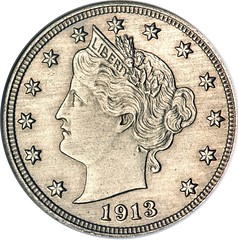 A specimen of the 1913 Liberty nickel owned by famous collector George O. Walton has been sold in a private transaction for an undisclosed
amount between $3 million and $4 million. The coin, co-owned by Jeff Garrett of Mid-American Rare Coin Galleries in Lexington, Kentucky, and Larry
Lee of Coin and Bullion Reserves of Panama City, Florida, was sold to two brothers, Martin Burns and Ronald Firman, and the deal was brokered by Bob
Paul of Bob Paul Rare Coins in Philadelphia.
A specimen of the 1913 Liberty nickel owned by famous collector George O. Walton has been sold in a private transaction for an undisclosed
amount between $3 million and $4 million. The coin, co-owned by Jeff Garrett of Mid-American Rare Coin Galleries in Lexington, Kentucky, and Larry
Lee of Coin and Bullion Reserves of Panama City, Florida, was sold to two brothers, Martin Burns and Ronald Firman, and the deal was brokered by Bob
Paul of Bob Paul Rare Coins in Philadelphia.
The Walton specimen, graded Proof63 by Professional Coin Grading Service (PCGS), previously transacted for $3,172,500 in April 2013 – well above its then-estimated value of $2,500,000. Two other specimens, owned by Louis Eliasberg and Fred Olsen, last took $5 million in 2007 and $3,737,500 in 2010, respectively.
To read the complete article, see:

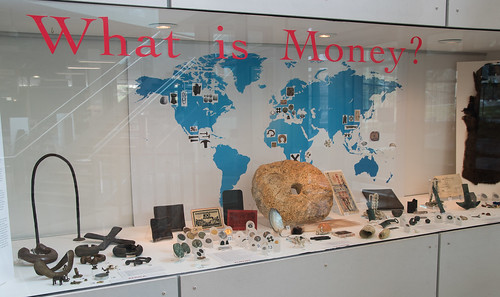
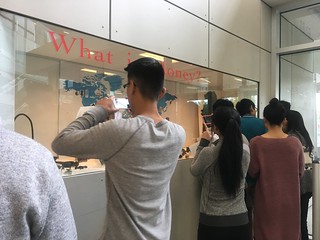 What is Money?
What is Money?Exhibition at Nickle Galleries
University of Calgary, Canada
May 3 – Sept 8, 2018
Curated by Marina Fischer

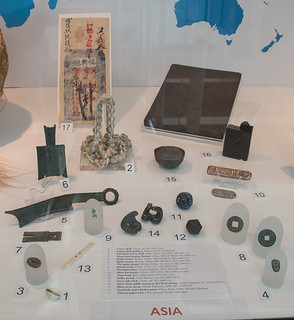
What is Money? is the newest exhibition of ethnographic objects from the Nickle’s numismatic collection, showcasing diverse forms of money used across the globe through time. From some of the earliest minted metals of the ancient world to Chinese knife money and African metalwork, from the Canadian Northwest Coast copper shields to unique stone money from the Island of Yap – the exhibition explores a range in cultural understandings of money, its value in society and asks, what is money?
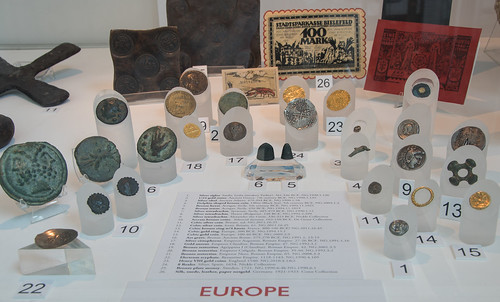
Located in the Taylor Family Digital Library (TFDL)
Hours: M-F: 8am-9pm, S: 10am-6pm, S: 10am-8pm
Event:
Exhibition talk and tour
Sept 8, 2018, 3-4pm
Website:
http://nickle.ucalgary.ca/Free admission
To read the earlier E-Sylum article, see:
With Pride Month celebrations recognizing LGBTQ history and culture throughout the country this June, what better way to highlight the occasion than by studying historical LGBTQ rulers with coins?
Throughout history, there are many examples of world leaders who for their gender expressions and sexual orientations would today be seen as members of the LGBTQ community. In some regions or eras, a range of expressions of gender and sexuality were accepted and even encouraged. In regions where certain forms of self-identification and expression were unwelcome, some individuals were still true to their own identity in their own ways. Chief among those who had the privilege of living and loving as they saw fit were historic rulers we would today describe as LGBTQ. It should be emphasized that although we would describe these rulers as gay, lesbian, bisexual, transgender, or queer today, that identification may not have been the way they would want to be described. These terms are modern constructs and are used as aides in telling these human stories.
These historic LGBTQ rulers, like so few other LGBTQ people, have been immortalized through coins from their eras. The National Numismatic Collection has several examples of such coins that represent a wide range of LGBTQ rulers throughout history.
Emperor Elagabalus, 203–222 A.D.

As an emperor, Elagabalus lived a privileged life that allowed for open expression. Beyond applying cosmetics and wearing women’s clothing, Elagabalus was known to have used self-referencing terms such as queen, lady, mistress, and wife. Indeed, Elagabalus is even said to have publicly married the male athlete Zoticus in a ceremony in Rome. Despite having many affairs, Elagabalus loved one man above all others, the chariot driver Hierocles, whom Elagabalus referred to by calling him husband. Though Elagabalus was assassinated in 222 A.D., the leader’s likeness—depicted as a traditional male emperor—is captured in the coinage minted during Elagabalus’s reign, such as on the gold Aureus pictured above.
Queen Cristina of Sweden, 1626–1689 A.D.
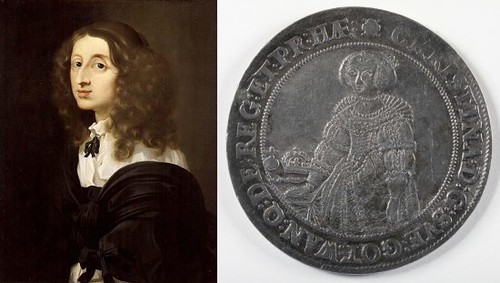
Queen Christina of Sweden’s father raised and educated the young heir like a boy. Christina ruled for 10 years, from the age of 18, before ultimately deciding to abdicate the throne in favor of a cousin, Charles X, so that Christina did not have to marry and could convert to Catholicism. Christina shocked many courts in Europe, including the Vatican, by wearing men’s clothing and acting in the manner of a man. Christina loved and had relationships with many women, including with Ebba Sparre, who was also a Swedish noble. Christina lived a long and interesting life and was later buried in the grotto at the Vatican. Many of the portraits and likenesses of Christina such as the silver taler above show the former leader in a more feminine light. Christina may have dressed differently than described for these portraits, or artists may have changed the portrait’s appearance to conform to social norms of the period.
However these historic LGBTQ rulers would have described themselves, what is apparent is that they were true to themselves, and to their love. LGBTQ history may be harder to uncover than other histories, but sometimes if you follow the clues and look closer at the written sources and objects from their eras, such as coins, their stories may slowly start to emerge. These coins help tell LGBTQ history in an unexpected way and convey the modern message: “we’re here, we’re queer, get used to it!”
To read the complete article, see:
THE BOOK BAZARRE
Have you ever done something so dumb that you can't believe you just witnessed yourself doing it?
You haven't? Er … well, this is awkward then. I was going for a, “Yeah Dave, I've done some really dumb stuff too,” sort of vibe here. Anyway, here's what happened with my adventure in stupidity.
A raw coin arrived in the mail for me last week. After I picked it up at the post office, I couldn't wait to see it in hand. So – like the eager genius I am I got into my car, opened the package right away and took the coin out of its 2x2 envelope. Instantly it slipped through my fingers and fell into a tiny seam in the center console of my car.
One moment it was in my hand; the next – gone like it never existed. If I had 100 more tries I couldn't have dropped another coin into that tiny gap.
When I recovered from the shock of it I furiously tried to get at the coin from various angles, with no luck. In frustration I briefly considered turning the car upside down and shaking it until the coin fell out, but that seemed impractical.
To recover it will require some major dis-assembly of the interior of my car. I have a good coin friend who fixes up cars for resale who I know could help, but I don't know if I want to subject myself to the ridicule that will most assuredly come with his assistance.
Its not even about the money – I just wanted that damn COIN! For 200 years it survived in delightful shape against all odds. Two world wars, several financial panics, one worldwide depression –it was still pristine. Now in one quick second it is part of a sedan. Ugh.
Actually, I have done something almost exactly like that. I need to flash my photo ID badge and smiling face to the guards every morning when I drive in to work. Usually my badge is in a plastic holder on the end of the lanyard around my neck. One morning as I approached the guard station I realized the badge was still in my wallet. I fumbled to get it out and tried unsuccessfully to slide it into its holder. Instead - you guess it - I dropped it between the driver's seat and center console.
So the credential that took a six-month long security investigation, psychological profile, and awkward drug test to earn had totally vanished. It's generally not a good idea to tell people with automatic weapons "no" when they ask for your ID. "Gee, you're really gonna think this is funny" doesn't elicit grins either. But I think they were amused watching me flail about trying to fish it out after pulling over.
Anyhoo, here are a few items that caught my eye in Making The Grade #39: -Editor
1860-1867) Japan Gold Koban
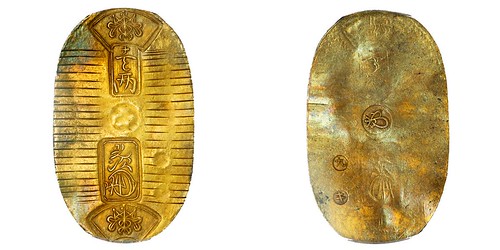
(1860-1867) Japan Gold Koban. PCGS graded AU-55. JNDA 09-23 Man'en ? ? variety.3.30 grams. And now for something completely different. This coin stopped me in it's tracks when I saw it – it is just that beautiful. Gorgeous green-copper-gold in color. Most of these are found damaged or repaired, most likely due to their somewhat delicate nature. I'd be willing to bet most serious coin collectors do not have even one Koban in their collection.
1717/6 8 Escudos, Spain
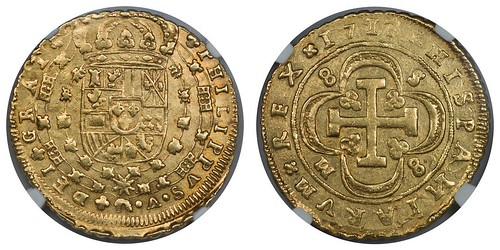
KM-260. The single highest graded coin of this rare date, and the highlight of this list. Flashy luster with russet color peeking around the rims
1861 CSA “Beauregard Dime”

1861 CSA “Beauregard Dime”. NGC graded Very Fine Details. A prized Civil War rarity. An article published in 1868 noted that these medals were “presented by the city of New Orleans immediately after the first battle of Bull Run." There are fewer than 10 specimens known, and nearly all are impaired in some way. This one is called, “VF Details, mount removed, obverse tooled” by NGC. It actually presents very well. There are several auction records around $10,000 and above. This one is just $5750.
To read the complete article, see:

Things at home were a little hectic for me last week and I didn't get a chance to write up the June meeting of my Northern Virginia numismatic social group Nummis Nova. So here's a short belated review.
Our host was Jon Radel. We met at a new Greek restaurant in Tysons Corner called Nostos. Wayne Herndon and I were the first to arrive and we sat down in a nice private room. We were able to have a good chat before others began to arrive, including Roger Burdette, Mike Packard, Steve Bishop, Gene Brandenburg, Dave Schenkman, Eric Schena and Jon himself.
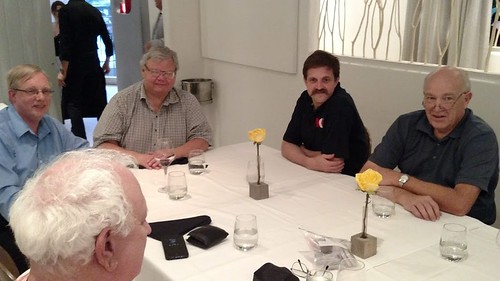
Bishop, Homren, Burdette, Herndon, Packard (photo by Eric Schena)
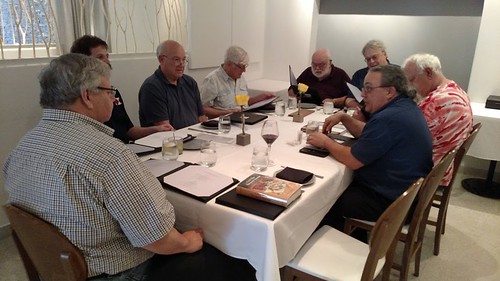
Burdette, Herndon, Packard, Schenkman, Brandenburg, Radel, Bishop, Schena (photo by Wayne Homren)
Some Books
Roger Burdette brought a copy of his new book on Saint Gaudens twenty dollar gold pieces. Since I'd recently spoken with my old friend Bob Kincaid of Nebraska about our work with Fred Reed on the Civil War Encased Postage Stamps book, I brought along my copy. Mike Packard brought the new book on Colonial-era counterfeits.
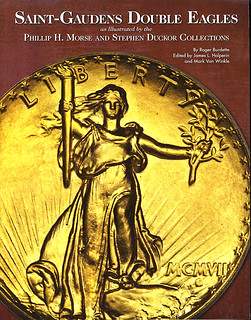
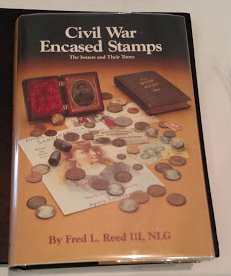
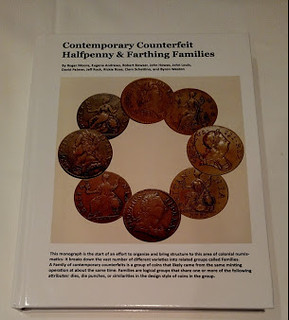
Some Merchant Counterstamps
Dave Schenkman recently purchased a collection that included some nice counterstamps, and he kindly provided these photos. You can always count on
seeing some great coins at our meetings.
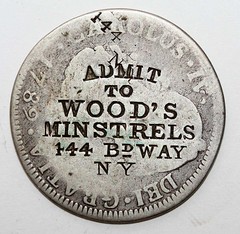
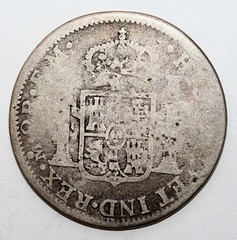
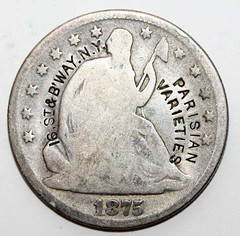

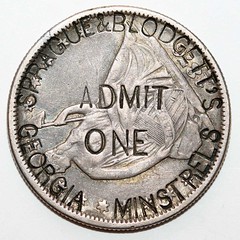
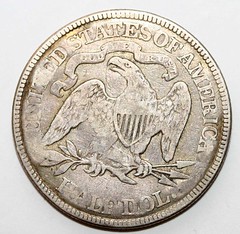
More Photos
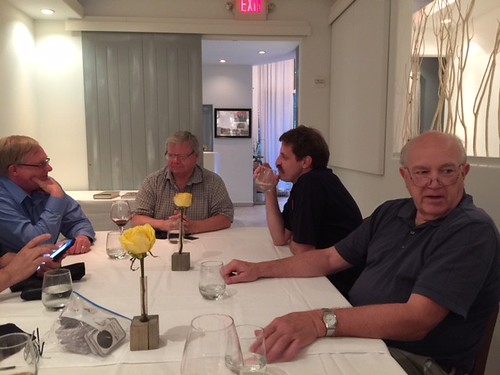
Homren, Burdette, Herndon, Packard (Photo by Gene Brandenburg)
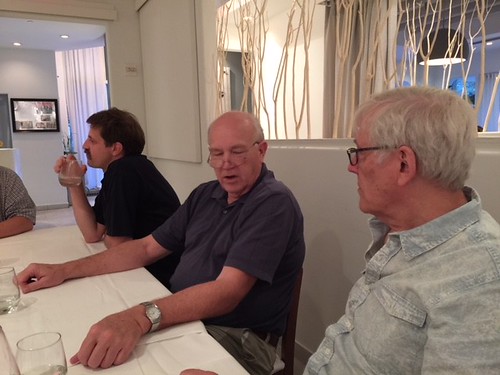
Herndon, Packard, Schenkman (Photo by Gene Brandenburg)
It was a fun evening - nothing beats a nice chance to sit down any talk numismatics with fellow birds-of-a-feather.
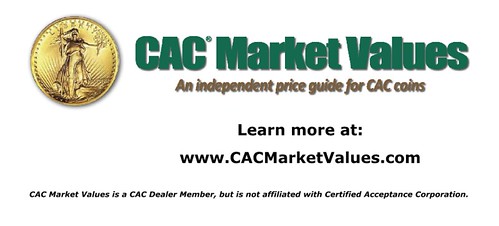
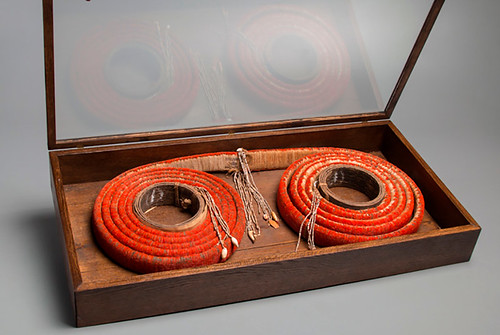
Among the most intriguing lots in Heritage Auctions' Ethnographic Art : American Indian, Pre-Columbian and Tribal Art Signature Auction June 26 in Dallas, Texas, will be a rare piece of feather money from the Southwest Pacific.
Solomon Islands Feather Money, Tevau, Santa Cruz (est. $8,000-12,000) is from the Santa Cruz Islands, which now is part of the modern Solomon Islands, an independent nation in the southwest Pacific, northeast of Australia. Classed in the numismatic world as "primitive money," it had all the monetary characteristics of today's modern coins from the world's high-tech mints, a means of accumulating wealth, a medium of exchange, a regulated value and a regulated supply.
The currency, which is wrapped into coils with a diameter of about 13 inches, was made from the feathers of a small, scarlet honeyeater bird found in the rain forest. Each piece of the currency incorporated the feathers of about 300 birds, the bark of a tree from the rain forest, colored seeds for decoration and pieces of turtle shell. Three specialists invested a combined 500-600 hours to create each piece.
The value of an individual piece of the currency was determined by the size and the richness of its color – the newer the feathers, the richer the color, and therefore the higher the value. Through natural deterioration and wear from handling, the coils gradually lost their color and eventually turned black, decreasing their value.
To read the complete article, see:
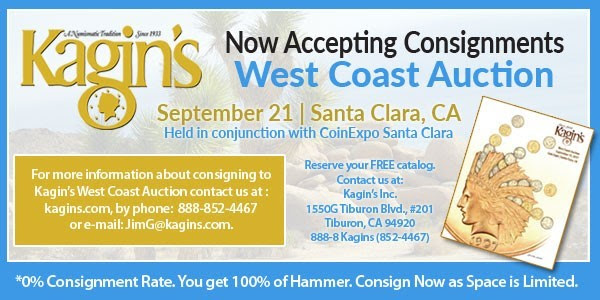
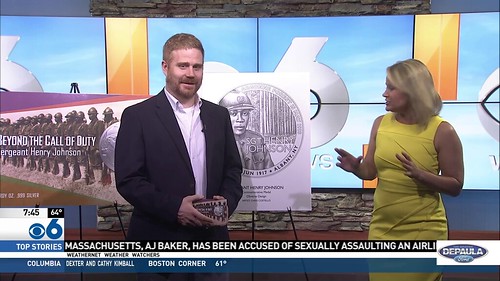
One of the nation’s oldest coin shops has minted 500 silver coin-shaped medals honoring African American World War I hero Sgt. Henry Johnson.
Ferris Coin Co. will premiere the medals at The Palace Theater in Albany, N.Y. on Wed. June 27. The medals are priced at $29.95.
On June 5, 1917, Albany resident Henry Johnson enlisted in the first African American unit in the U.S. Army to engage in combat in World War I. On May 15, 1918 in the early morning hours, then-Private Johnson heroically fought off a German raid in hand-to-hand combat, saving the life of a fellow soldier. He was wounded 21 times. For his bravery, Johnson received France’s highest award for valor, the Croix de Guerre avec Palme, becoming the first American to receive this distinction. He received no military medals from his home country during his lifetime.
Sgt. Johnson returned to Albany in 1919 and struggled to readjust to civilian life and hold down steady work. He died, destitute, in 1929, in his mid-30s. He is buried in Arlington National Cemetery.
Sgt. Henry Johnson was finally recognized by the United States government for his service to his country when he was posthumously awarded the Purple Heart in 1996 and the Distinguished Service Cross in 2002. In 2015 he was awarded the National Medal of Honor -- the nation’s highest military honor -- by President Barack Obama.
NATIONAL DESIGN CONTEST
In March, Ferris Coin Co. announced a nation-wide competition to design the obverse and reverse sides of the medal with a $1,000 prize per side. An
expert jury composed of esteemed professional artists and a representative of the 369th Veteran’s Association (the regiment Johnson served with)
evaluated the contest entries. Artists of all levels from across the country submitted designs, including several artists whose work has been
featured on U.S. Mint coins and one world famous medallic sculptor.
Though the jury was free to select any combination of designs, it chose both of Chris Costello’s designs for the front and backside of the medal. Costello’s artwork has appeared on 23 U.S. coins and medals, including one Congressional Gold Medal.
A native of Kingston, N.Y., Costello now lives in Arlington, Mass.
THE MEDAL
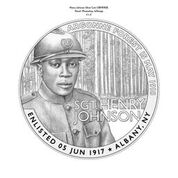 The obverse presents Sgt. Henry Johnson in the foreground in uniform, wearing the French Adrian helmet, which was the helmet most commonly
worn by solders of the 369th U.S. Regiment a.k.a. the “Harlem Hellfighters,” rather than the English or American “doughboy” helmet. In the background
is a forest. The text reads: “Argonne Forest 15 May 1918” and “Sgt. Henry Johnson” and “Enlisted 05 June 1917.”
The obverse presents Sgt. Henry Johnson in the foreground in uniform, wearing the French Adrian helmet, which was the helmet most commonly
worn by solders of the 369th U.S. Regiment a.k.a. the “Harlem Hellfighters,” rather than the English or American “doughboy” helmet. In the background
is a forest. The text reads: “Argonne Forest 15 May 1918” and “Sgt. Henry Johnson” and “Enlisted 05 June 1917.”
The reverse features Albany City Hall and a representation of adjacent State Street with a rising morning sun. The text reads: “Sacrifice Today for Our Community’s Tomorrow” and “Honor * Duty * Service”
To read the complete article, see:
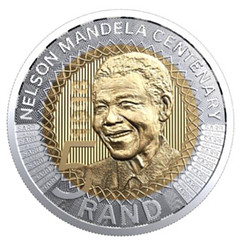

South African banknotes and R5 coins will soon carry the face of late president Nelson Mandela in celebration of his 100th birthday.
The South African Reserve Bank (SARB) released the designs of the commemorative banknotes on Wednesday ahead of its official release, after the designs surfaced on social media.
As part of the preparations for the launch, test packs of the commemorative banknotes were made available to members of the broader cash industry to allow them to make adequate preparations in relation to issues such as adaptions of cash processing and cash dispensing machines, ticketing machines and so forth," the bank said in a statement.
The notes will co-circulate for a limited time, together with the current Mandela banknote series and the existing R5 coin, and both sets will remain legal tender.
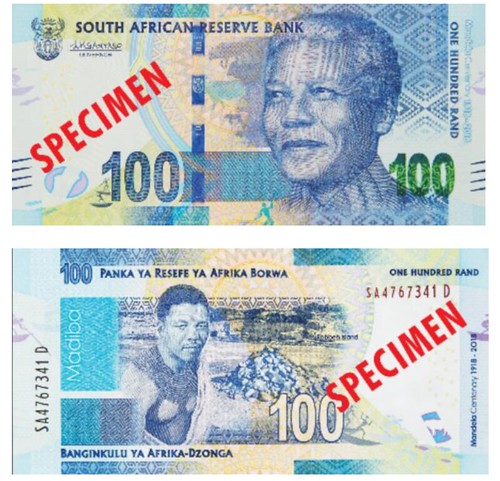
To read the complete article, see:


The Clydesdale and Yorkshire bank brands are set to disappear from high streets after Virgin Money agreed to a £1.7bn takeover by the owner of the two institutions that will lead to the loss of more than 1,500 jobs.
Clydesdale and Yorkshire Bank Group (CYBG) will combine with Virgin Money to create the UK’s sixth-largest bank, with 6 million personal and small business customers, and total lending of £70bn.
While it is CYBG in the driving seat, it is the Virgin Money brand that customers will see in future. The deal signals the end of a high street presence for the Clydesdale Bank brand, which was established in Glasgow in 1838, and its sister brand Yorkshire Bank, which was founded in Halifax in 1859. There are 70 Clydesdale Bank branches and 97 Yorkshire Bank outlets.
The deal also prompted online speculation that because Clydesdale is one of only a small number of banks worldwide that issues its own banknotes, there could soon be Virgin Money notes – perhaps even featuring a portrait of Sir Richard Branson – circulating in Scotland. However, the bank note-issuing licence is in Clydesdale’s name and CYBG has indicated there are no plans to make changes to the notes.
To read the complete article, see:

Distrusted at first by some as dodgy cash, a special World Cup 100-ruble ($1.57) banknote with a picture of iconic Soviet goalkeeper Lev Yashin has become a collectors' item, with Russians willing to pay several times its face value to get their hands on it.
Tinted in hues of blue, yellow and green, the note features a boy dressed in a football jersey and holding a ball as he watches a diving Yashin – an image that is meant to symbolize the appeal of football across generations.
Before the tournament got under way last week, some traders in Yekaterinburg were reluctant to accept the unfamiliar polymer notes, which came into circulation less than a month ago.
Now, demand has gone through the roof.
"We've run out of them. We were told we may get more but we're not 100 percent sure. We're still waiting," said Marina Gorbunova, a bank teller at the cavernous Sberbank branch in central Yekaterinburg.
Another bank employee, Dmitry, said more than 300 people, mostly Russians, had queued up on Saturday to obtain the limited-edition notes.
A local coin seller said he had none available but that they were going for six times face value in smaller kiosks, while some fans had paid up to 900 rubles in nearby Vaynera Street. Chinese collectors, he added, were particularly keen.
To read the complete article, see:

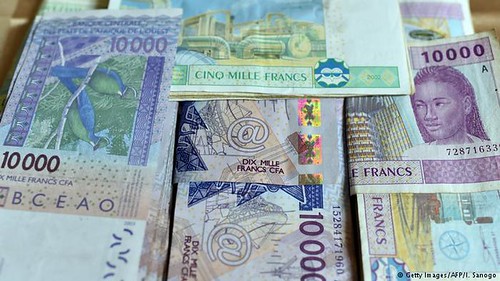
A group of young African rappers is challenging the use of the common currency, saying the CFA franc is a remnant of colonialism and should be abolished. But members of the African elite don't seem interested in change.
"7 minutes contre le CFA" ("7 minutes against the CFA franc") — this is the title of a new rap song which was officially released on Wednesday in the Senegalese capital, Dakar. Ten musicians from seven African countries are mobilizing opposition to the common currency of a total of 14 countries in West and Central Africa. Their main criticism: the currency is a remnant of the French colonial era and is an affront to the sovereignty of African states.
Strictly speaking, the CFA franc is the name given to two currencies used in the African Financial Community. In West Africa, eight countries share the common currency known as the West African CFA franc: Benin, Burkina Faso, Ivory Coast, Guinea Bissau, Mali, Niger, Senegal and Togo. The central bank is located in Dakar. The Central African CFA franc is the common currency in six other countries: Equatorial Guinea, Gabon, Cameroon, the Republic of Congo, Chad and the Central African Republic.
Both currencies have existed since 1945, when they were both linked to the French franc. At the moment, one euro is worth approximately 656 CFA francs. The French central bank guarantees the value of both currencies. In return, the African countries are required to deposit 50 percent of their currency reserves in Paris.
Colonial-era currency
The CFA franc is undeniably a colonial-era currency which was created by France for its former overseas territories in Africa, says Armin Osmanovic,
who heads the Rosa Luxemburg Foundation in Dakar.
But after 7 minutes, one question remains unanswered: If the CFA franc goes, what comes next? Should there be a new common currency? One restricted to just a few countries? Or should African countries go back to using their national currencies?
"The discussion around this issue is being led by the rappers, as well as by economists and — in France — people on the political left," says Osmanovic. "Many are speaking out against the CFA franc, but the way forward is still very unclear and politicians are reluctant to discuss the issue publicly." It is not expected to play a large role in upcoming elections in the region, for example in Senegal.
To read the complete article, see:
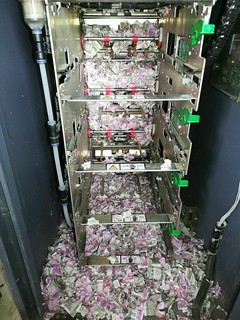 Technicians who arrived to fix a malfunctioning cash machine in the Indian state of Assam got a shock when they opened it up.
Technicians who arrived to fix a malfunctioning cash machine in the Indian state of Assam got a shock when they opened it up.
Notes worth more than 1.2m rupees (£13,300; $17,600) had been shredded - and the suspected culprits are rats.
Police said the rodents probably entered the machine through a hole for wiring, the Hindustan Times reported.
Pictures of the chewed cash at the State Bank of India branch in Tinsukia district were widely shared on Twitter.
One shows a dead rodent lying in the debris.
Police official Prakash Sonowal said that the machine had been out of action for about 12 days, the Hindustan Times added.
Technicians who took the unit apart found banknotes of 2,000 and 500 rupee denominations destroyed. They managed to salvage another 1.7m rupees, officials said.
To read the complete article, see:
RETRO_STU on Flickr notes:
For anyone who's seen rodent chewed paper - the paper in the above picture does NOT look rat-chewed!!! More to that story than meets the eye.
Film-making associations met with the police, the Hong Monetary Authority and government representatives yesterday to clarify procedures and requirements for using prop banknotes.
The Crimes Ordinance says a person who reproduces any Hong Kong banknote without consent in writing from the Monetary Authority will commit an offense.
However, not all those in the film industry were aware of the clause until two of them were given two-year suspended sentences for possessing 200,000 in fake banknotes that were labeled "props."
The authority requires anyone who intends to reproduce banknotes to submit a written application. It will then decide whether to issue an interim approval for the applicant to prepare a sample of the prop banknote, which will be reviewed by the authority and the Commercial Crime Bureau. After confirming the samples and details, written approval will be issued.
At the meeting, the authority said "a set of samples will be attached to the existing guidelines to demonstrate the required size of the prop banknotes and the distinguishing designs and features required to set them apart from genuine currency."
"An application form will also be attached to the guidelines to assist applicants in providing the required information," it said.
After the meeting, the vice chairman of the Hong Kong Film Arts Association, Alex Mok Siu-chung, said the previous application procedures were confusing. He said the meeting helped build a platform for mutual understanding. The industry will adhere to the authority's requirements.
To read the complete article, see:
To read the earlier E-Sylum article, see:
Long before Bitcoin, back in 1998, Bernard von NotHaus developed the asset-backed Liberty Dollar (LD) into the most successful alternative/digital currency, behind only the US Dollar. This resulted in over $50 million dollars of gold and silver-backed currency entering circulation and ultimately three federal convictions of counterfeiting as “current money”. Instead of life in prison, he served a short probation with house arrest and eventually the federal judge forced the FBI to return virtually all of the seized $7 million in silver to their rightful owners. After that almost ten-year legal saga, Bernard von NotHaus was a free citizen in December 2015. And today the Liberty Dollar legacy lives on in the new asset-backed cryptocurrency, LD2!
LD2 is a cryptocurrency poised to bring old-school, value-based monetary principles to modernday cryptocurrencies. Developed by Bernard’s son, Extra von NotHaus, and a Currency Officer of LD, Steven Brendtro, LD2 mirrors the original Liberty Dollar in that every digital token is backed by real, physical, precious metals. Custom minted one troy ounce silver LD2 coins are stored in a secure vault, backing up every single digital LD2 token issued. According to cofounder Extra von NotHaus, “LD2 is reimagining my father’s very successful concept of an asset-backed currency by bringing it into the modern technological paradigm of blockchain, which significantly improves the functionality and utility.”
All digital tokens issued by LD2 can be redeemed for the actual minted silver coins with true market value. Enhancing the versatility and usefulness of LD2 is its integration of the Ethereum blockchain technology, making it easy for existing cryptocurrency users to jump on board. Unlike the more common security-based Initial Coin Offerings (ICOs) that are in the news almost everyday, these are actual hard, physical assets, tokenized on the Ethereum blockchain. This innovative precious-metal-backed cryptocurrency is being released in these two initial phases:
• LD2.zero is currently offering 10,000 digital tokens backed by a stunning one troy ounce .999 fine silver 20th Anniversary Liberty Dollar commemorative coin
• LD2.silver will be an open-ended issuance of silver-backed LD2 digital tokens
To read the complete press release, see:
PR: LD2 Launches a True Asset-Backed Crypto, Continuing the Liberty Dollar Legacy (https://ld2coin.io/wp-content/uploads/2018/06/LD2-PR-v8.pdf)LD2 is an asset-backed cryptocurrency that facilitates vaulted, physical, ownership of precious metals and the real-time trading of physical precious metals. LD2 embodies the spirit, methodology, principles and community of the Liberty Dollar currency. The management of LD2 LLC leverages years of operational and market experience from Liberty Dollar, which issued over $50 Million USD of silver and gold into circulation through its physical and digital, private alternative currencies. Building on this predecessor, LD2 aims to function as a “stablecoin” – a globally liquid, value-stable, low-volatility cryptocurrency, without a central bank, that’s 100% backed by, and 100% redeemable at any time, in precious metals.
The LD2 cryptocurrency is a blockchain-based digital warehouse receipt , issued by [ISSUER], with the precious metals backing on deposit with the [DEPOSITORY], and the [AUDITOR] providing a monthly examination of all holdings. The [AUDITOR] works on behalf of the token holders to verify that all issued tokens are backed by the prescribed amount of precious metals. This third-party vaulting verification and independent auditing ensures that there is exactly one troy ounce of physical precious metal in the vault for each token issued, at all times – independent of token ownership.
As a digital warehouse receipt, every LD2 token is fully redeemable through the [DEPOSITORY] for its precious metals backing. Physical redemption not only structures LD2’s economic and value proposition, but builds trust with token holders, something badly needed in the cryptocurrency ecosystem.
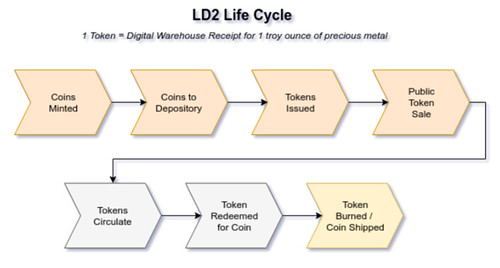
The idea of a paper currency had been suggested in an anonymous British pamphlet in 1650, but the proposal was modeled on the receipts issued by London goldsmiths and silversmiths for the precious metals left in their vaults for safekeeping.
In a recent interview Goldman Sachs CEO Lloyd Blankfein shared his views on the future of crypto-economy. He's got a good perspective on the evolution from "real" money to fiat currency and beyond. -Editor
Blankfein cited the inception of cell phones as an example to make a point that it is hard to predict what an invention is worth until it has been introduced as a utility. He added that any forecast regarding the future success of cryptocurrencies is only possible through postulation or hindsight, and further connected it with evolution, saying:
“You start out with gold as money, and people only take hard currency and you make gold coins. A gold coin is worth five dollars. You had five dollars in gold and eventually they would give you a piece of paper with a promise that there was five dollars in gold to back the five-dollar piece of paper and you could redeem it. Then they gave you a piece of paper and said there’s five dollars of gold but you can’t redeem it.”
He continued the dialogue with a sarcastic statement indicating the recent scenarios of our economic system:
“And at some point they give you a piece of paper and say it’s worth worth five dollars, you can’t redeem it, you don’t have it. We don’t have it even if you wanted it. And we’re still doing it today”
In Blankfein’s opinion, if we as a society could go through this “morphing” from gold coins to fiat currency where the center makes the most important decisions, then we cannot entirely erase the possibility of a consensus currency. He wisely closed the discussion, saying:
“I’m not in this school of saying – because it’s uncomfortable with me, because it’s unfamiliar, this can’t happen. That’s so arrogant.”
To read the complete article, see:
To read the complete LD2 White Paper, see:
To visit the LD2 web site, see:
https://ld2coin.io/To read the LinkedIn profile of Extra von NotHaus, see:
To read the Coin World article, see:
To read earlier E-Sylum articles, see:
LIBERTY DOLLAR CREATOR BERNARD VON NOTHAUS SENTENCED (http://www.coinbooks.org/esylum_v17n50a16.html) IN OTHER NEWS: JUNE 24, 2018
Kagin’s Accepting Bitcoin
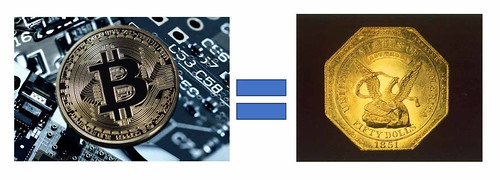
Donald H. Kagin, Ph.D., president of Kagin’s, Inc. and Kagin’s Auctions announced today that their 85 –year-old numismatic firm will be accepting Bitcoins, a form of crypto-currency, in payment for their rare coins and currency inventory, as well as for auction lots in their upcoming West Coast Auction on September 21, 2018.
Kagin’s has been known for decades as numismatic innovators, marketing through Amazon, the Saddle Ridge Hoard—the largest buried treasure find in North America, initiating auction cover design contests, and introducing the first numismatic loyalty program.
“I love pushing the envelope by offering better ways to acquire numismatic properties and educate potential collectors to our fascinating field,” declared Kagin who earned the nation’s first B.A. and Ph.D. degrees in numismatics. “By accepting Bitcoins we can turn virtual money into a tangible asset. Not only will the new owner receive a physical medium of exchange of known value, which is both private and portable, but also can have fun doing it!
“By being one of, if not the first major auction house to offer this facility, Kagin’s can pave the way for other auction houses, not only in numismatics, but for all collectables, to accept cryptocurrency. We believe that this will not only stimulate the virtual currency world but add to the demand for rare coins and currency,” predicted Kagin.
A small 1% processing fee will be passed on to all Bitcoin purchases. View current inventory as well as upcoming auctions at www.Kagins.com. Or for more information contact Nina@Kagins.com or call 888-8KAGINS (852-4467).
The Dahlonega Mint
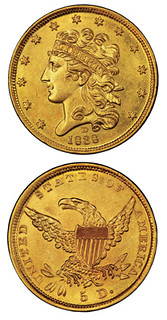 If present-day collectors see a coin with the mintmark D, they automatically assume that it was struck at Denver. This was not always true,
because before 1862, this mintmark meant something quite different. Dahlonega, in northern Georgia, began striking gold coins in 1838 and continued
to do so until the work was ended by the Civil War. The story of this little-known mint began nearly two centuries ago.
If present-day collectors see a coin with the mintmark D, they automatically assume that it was struck at Denver. This was not always true,
because before 1862, this mintmark meant something quite different. Dahlonega, in northern Georgia, began striking gold coins in 1838 and continued
to do so until the work was ended by the Civil War. The story of this little-known mint began nearly two centuries ago.
Gold was first discovered in the Dahlonega region in the late 1820s. In the fall of 1830, a Georgia gunsmith named Templeton Reid established a private mint and started to coin gold pieces in three denominations, $2.50, $5, and $10. He was soon out of business, however, because his assays were unreliable, and newspaper attacks made certain that everyone knew of this problem.
Although Reid’s mint and coinage were soon a dim memory, the idea of a federal mint in the gold region was not; at the same time, there was agitation at Charlotte, North Carolina, for a similar institution. Powerful political forces soon backed the Southern boosters, and in March 1835, President Andrew Jackson signed into law a bill establishing not only the Dahlonega and Charlotte mints but also one at New Orleans.
In far-off Philadelphia, Mint Director Samuel Moore had tried to derail the legislative process through his friends in Congress, but in the end found himself facing the inevitable. The facts of the matter were that it was far cheaper, including insurance, to send the gold to Philadelphia to be coined
To read the complete article, see:
The Naftzger-Browning 1933 Double Eagle
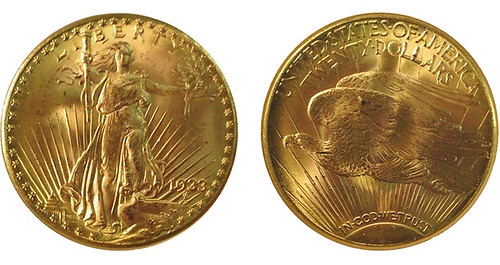
Professional numismatist Julian Leidman says he never had any reservations about selling, nearly four decades ago, a 1933 Saint-Gaudens double eagle. That coin is the specific coin most recently surrendered to federal authorities, its holder in fear of being accused of possessing stolen government property.
Mint officials have maintained for years — and affirmed through a 2011 civil trial — that all privately held extant 1933 double eagles (except the King Farouk specimen “monetized” following its auction in 2002) are stolen government property. The Mint maintains the pieces were never monetized through official government channels, and so considers them to be chattel, not coins. Some in the numismatic community dispute the Mint’s concept of “monetized,” saying that what the Mint claims now was not the practice in 1933.
Leidman, the owner of Bonanza Coins in Silver Spring, Maryland, is among those skeptical numismatists. He says he considers struck pieces of metal bearing designs, a date, denomination and country of issuance to be coins. He says he would have no qualms about buying and selling a 1964-D Peace dollar, another U.S. issue that authorities deem illegal to own since none of the 316,076 pieces struck at the Denver Mint were ever released into circulation.
To read the complete article, see:
What is an Illuminated Manuscript?
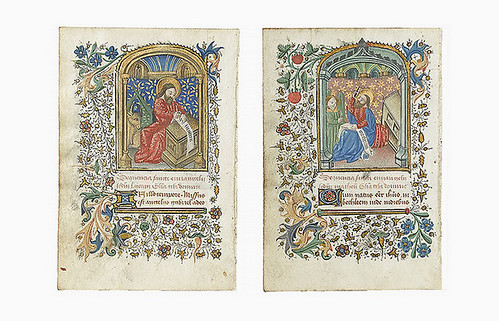
Before the invention of the printing press by Johannes Gutenberg in 1439, books were crafted individually by hand. One of the most elaborate books in art history was the illuminated manuscript—a unique, handcrafted book most commonly used to recount religious scripture and lore. As the name implies, illumination is the practice of decorating book pages with glimmering gold or silver leaflets, rich pigments, intricate borders, and even elaborate paintings. These embellishments imbued text with “light” and turned each book into an elevated experience.
What is an illuminated manuscript?
An illuminated manuscript is a handwritten book in which the text is decorated in gold or silver and the pages are filled with illustrations and
decorative motifs. Due to the amount of work involved in creating them, illuminated manuscripts have been regarded throughout history as valuable
religious relics. Contemporary historians see them as dazzling works of art, while collectors often seek out individual leaves for decorative
purposes as they are among the most affordable artifacts from the pre-Renaissance period. Most importantly, illuminated manuscripts are artifacts of
a bygone tradition and remind us how people shared knowledge and stories before technological innovations were possible.
To read the complete article, see:

